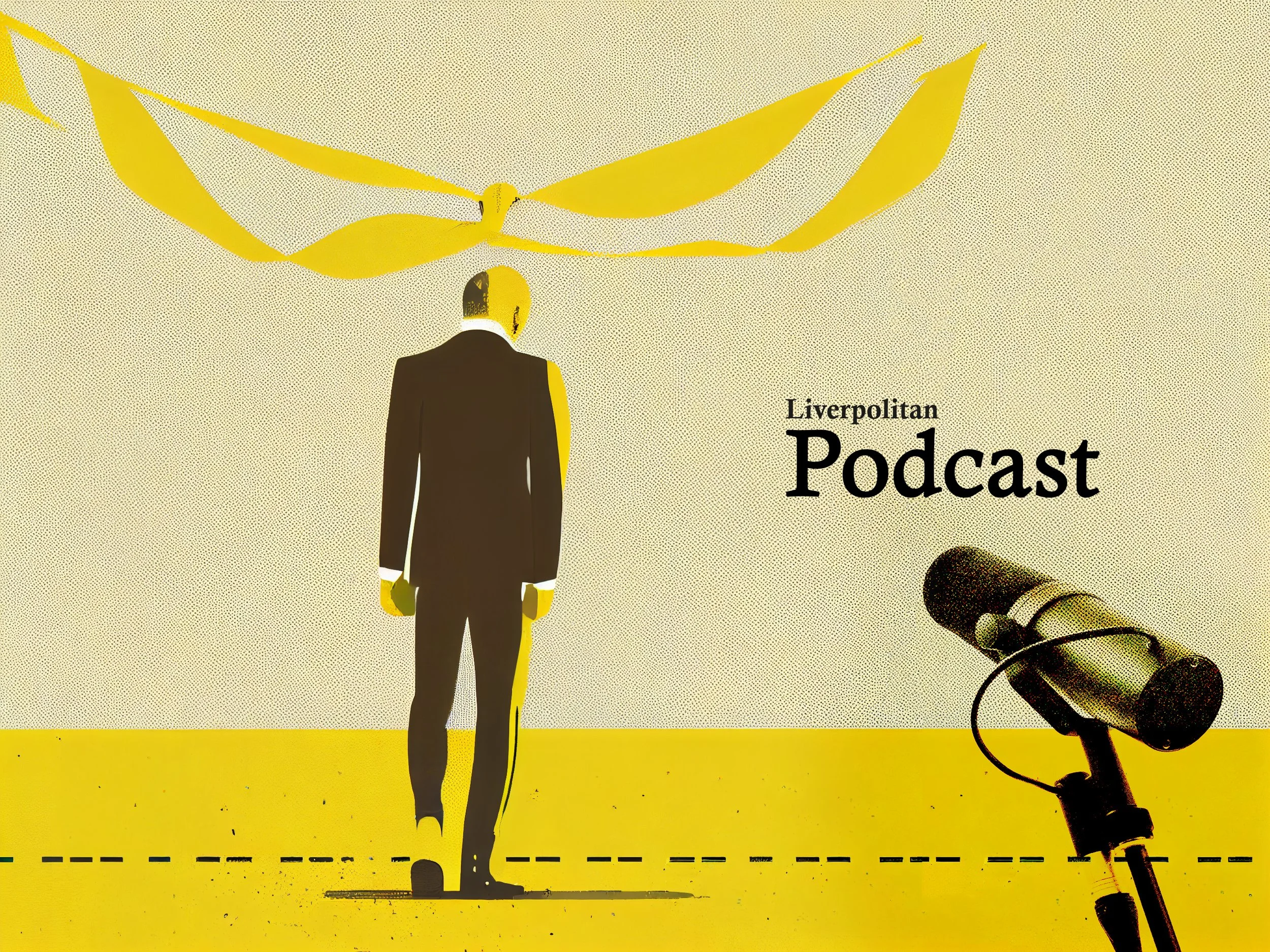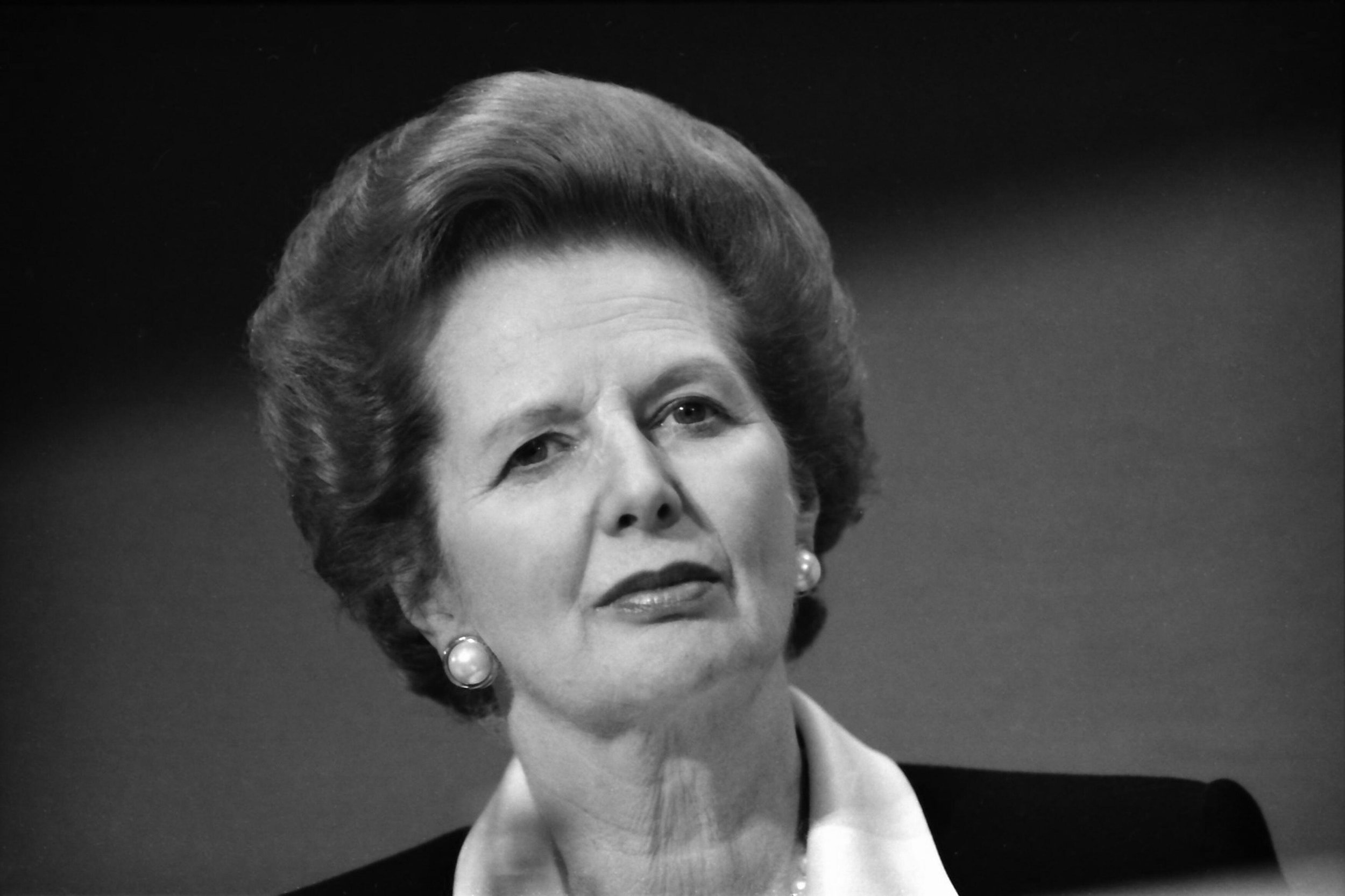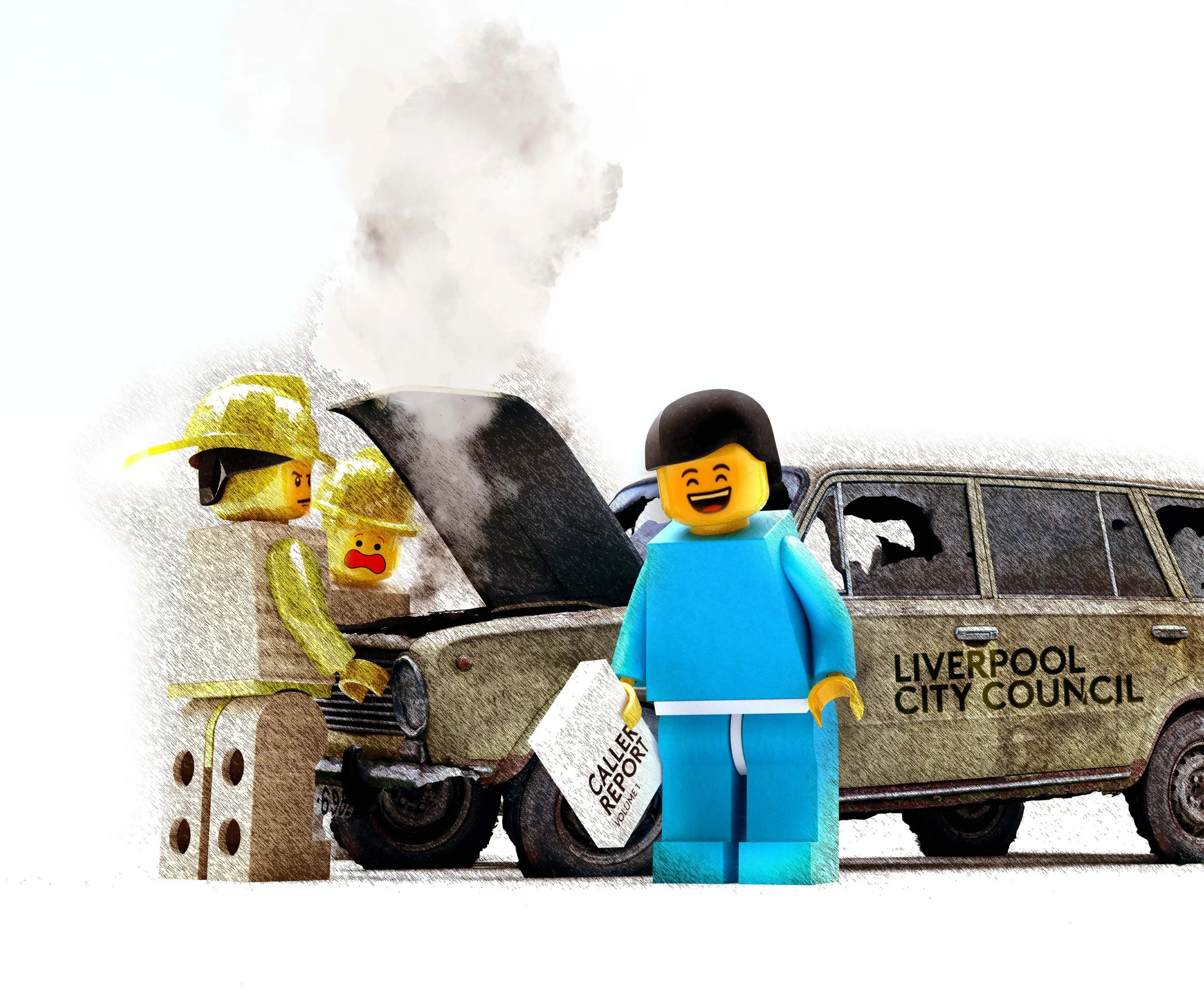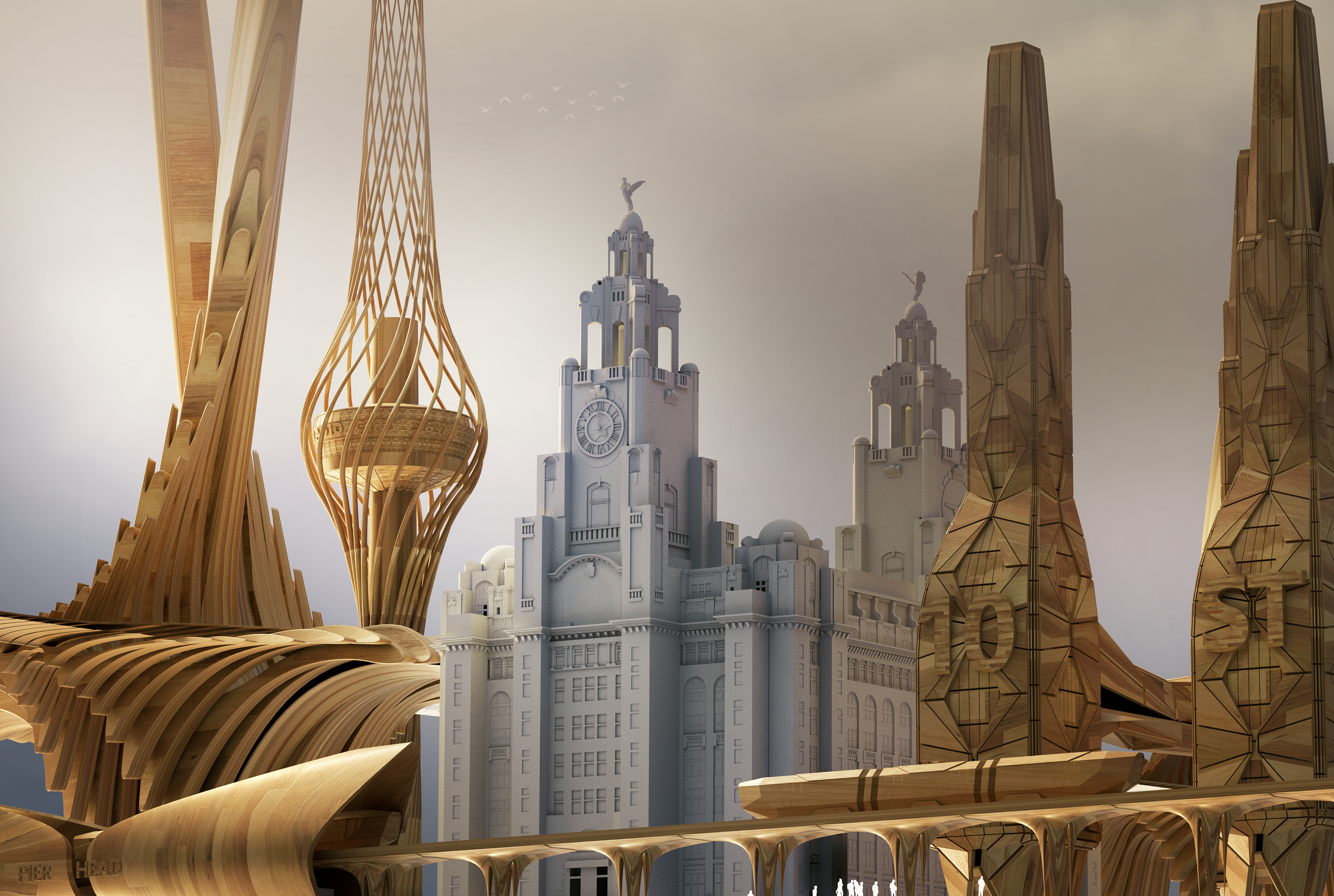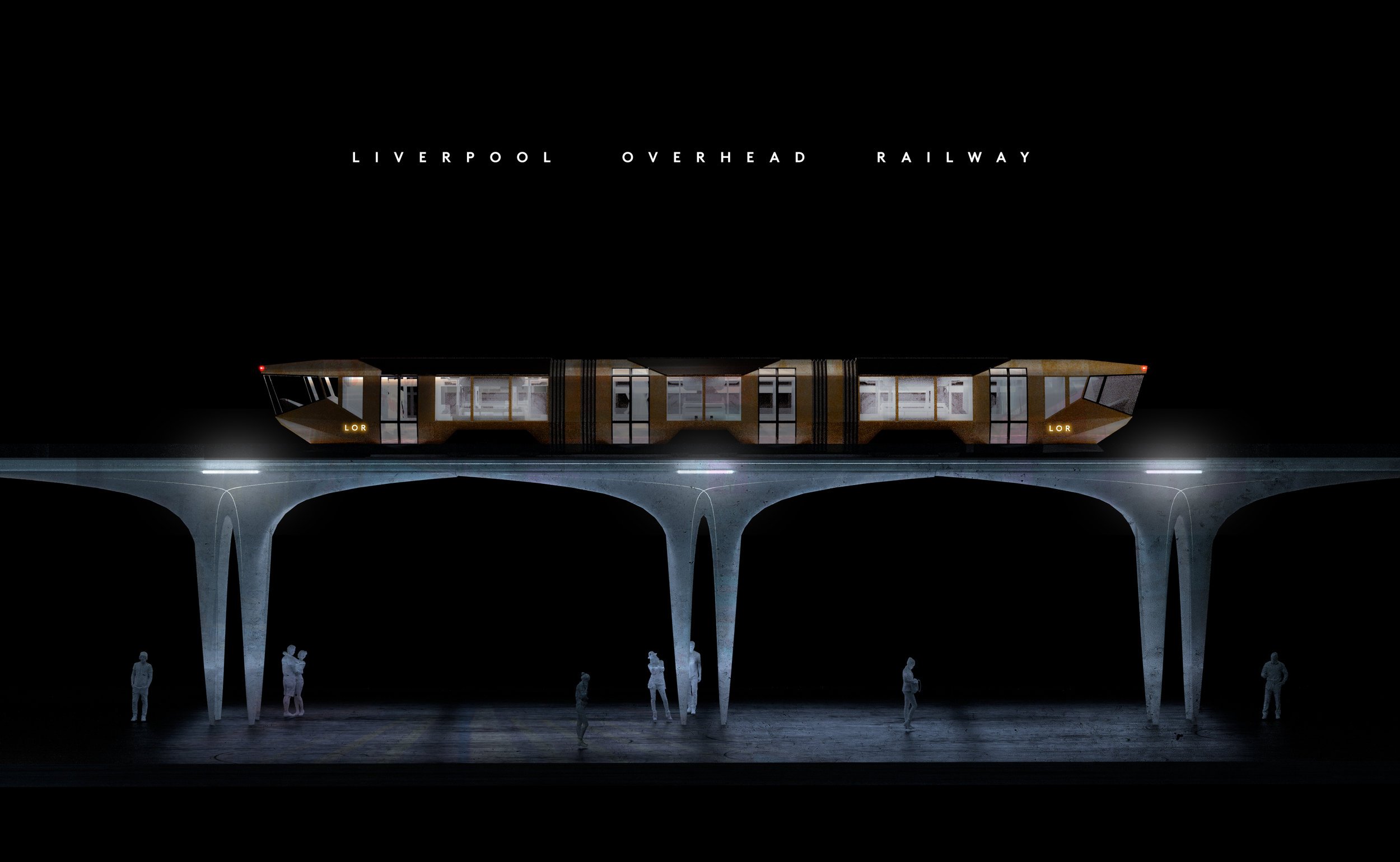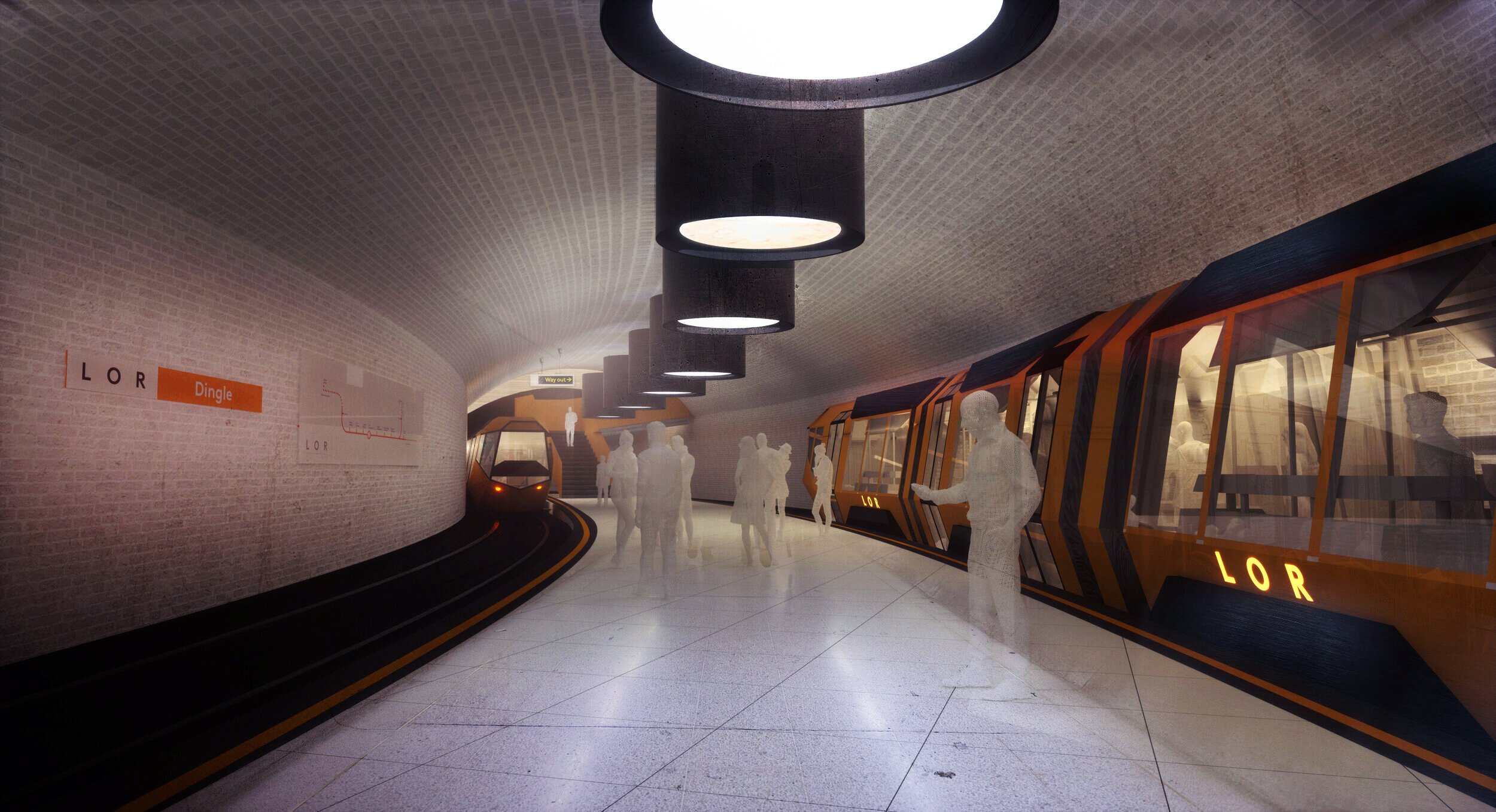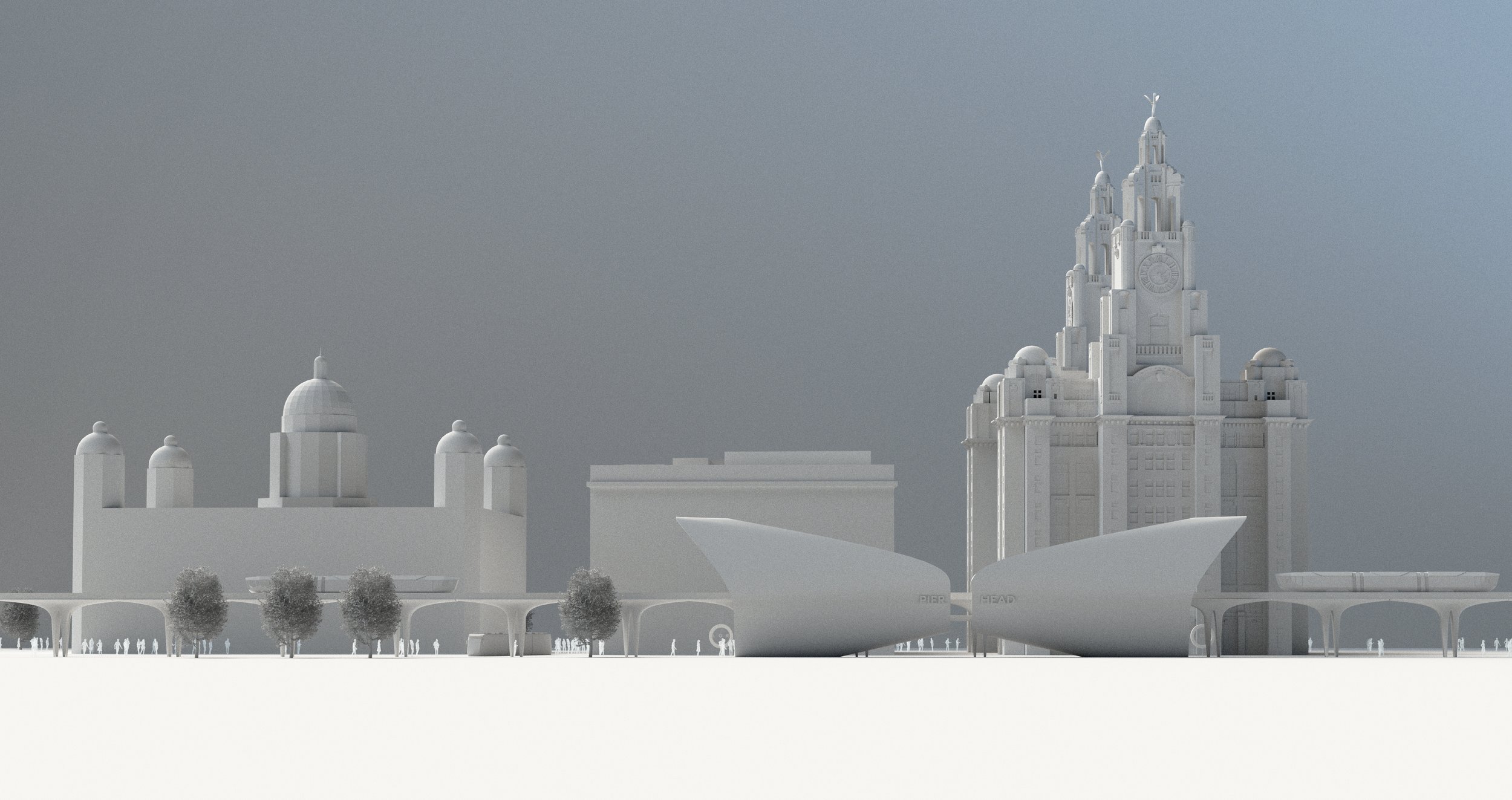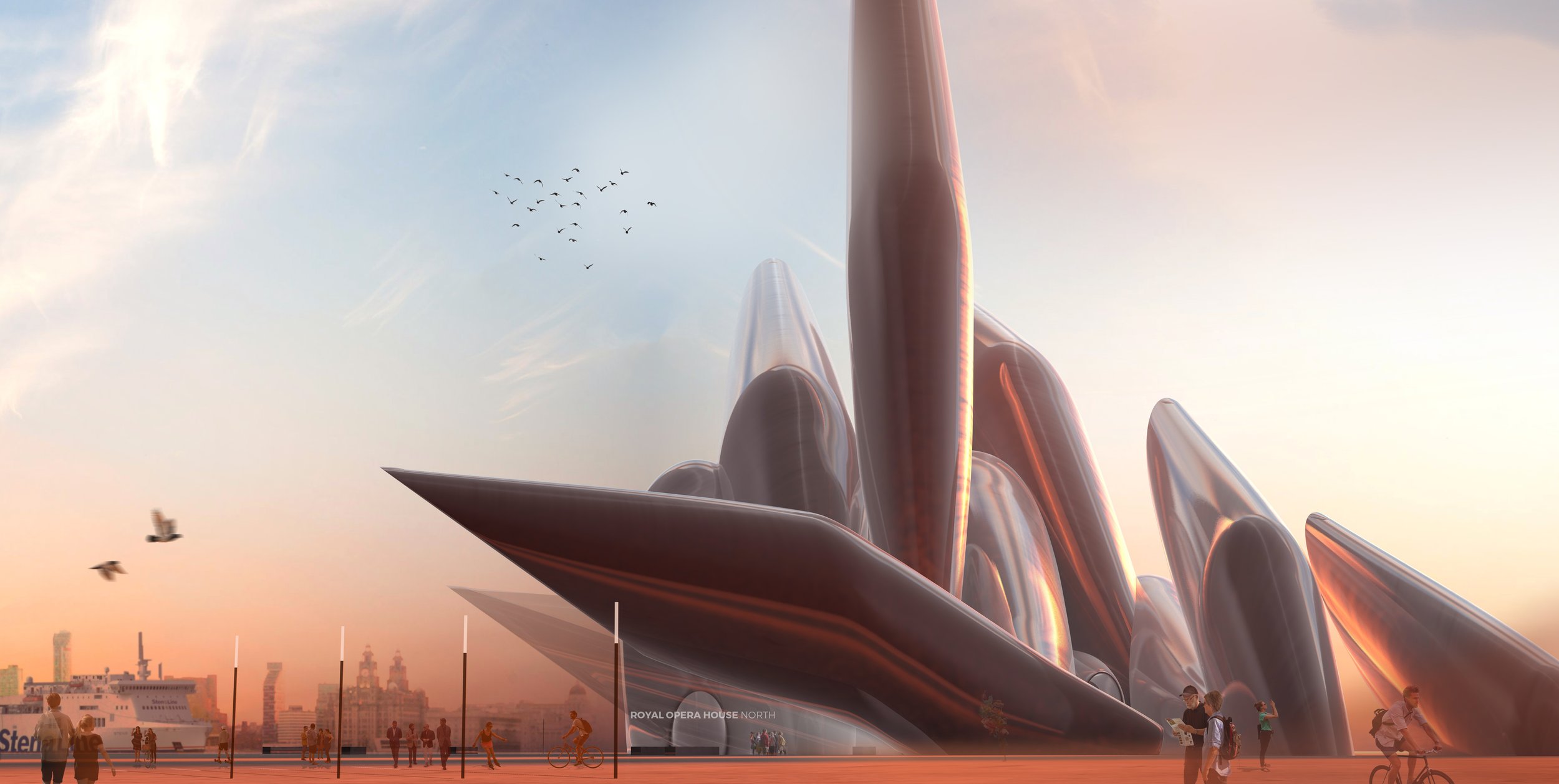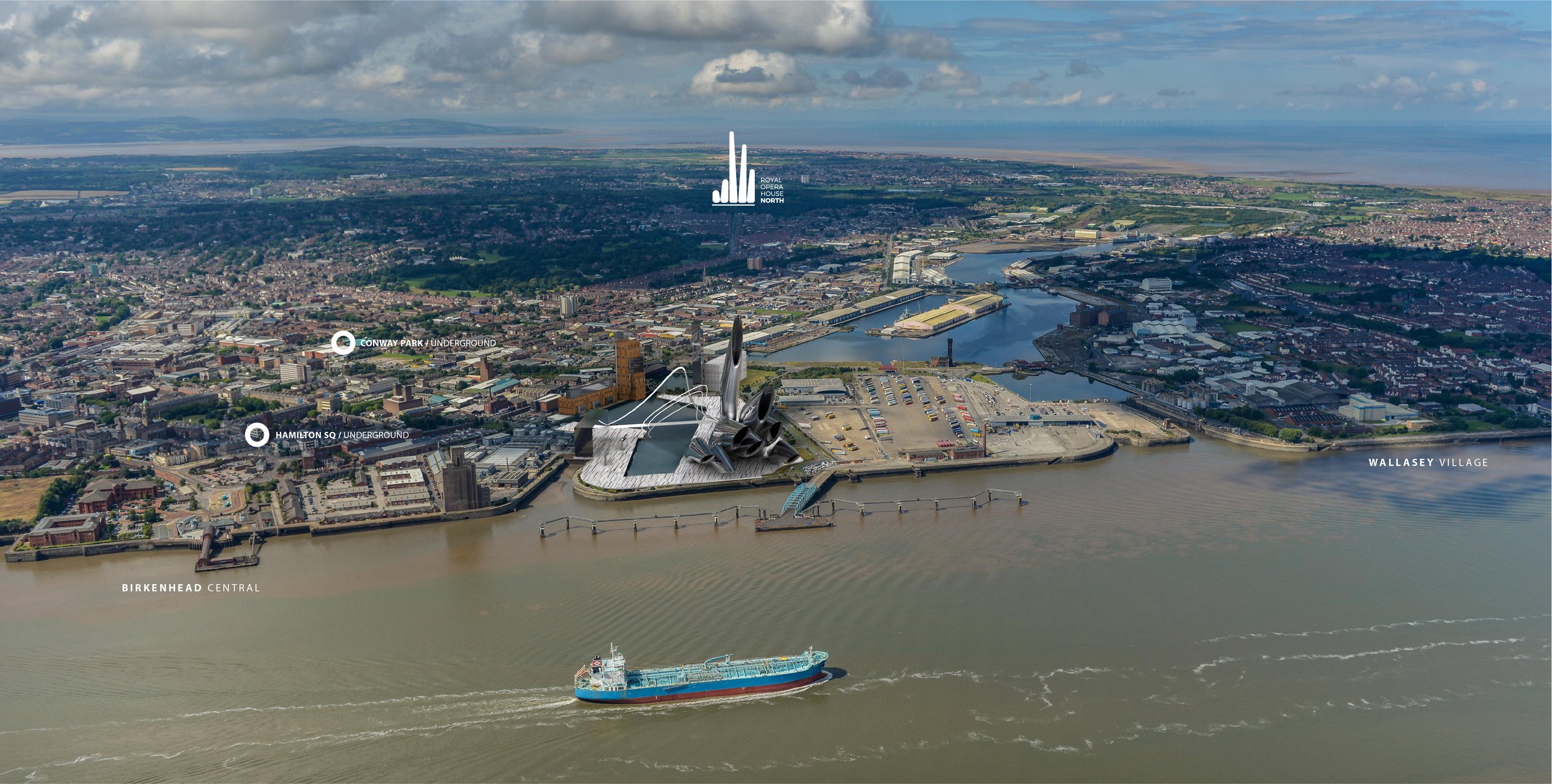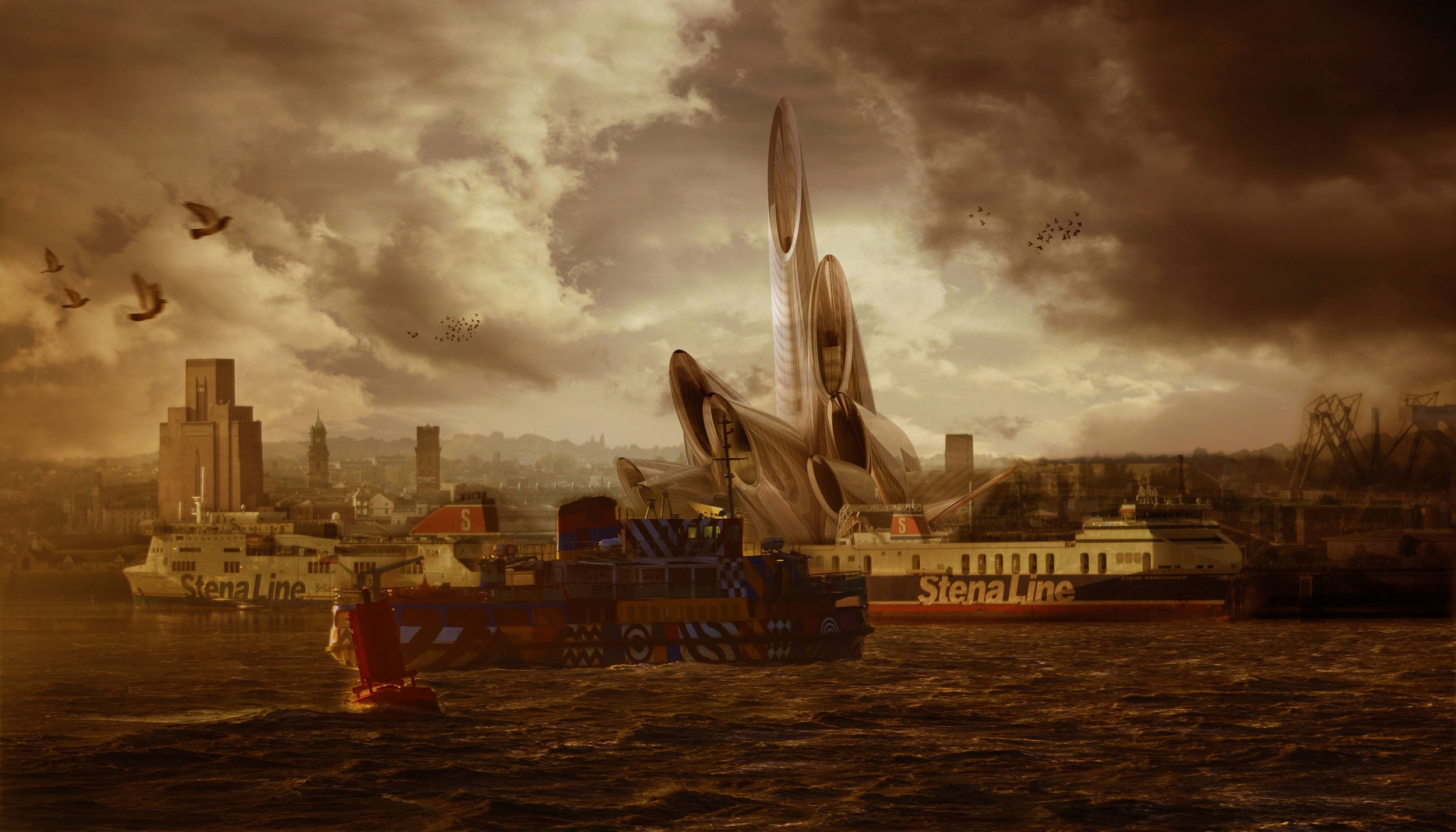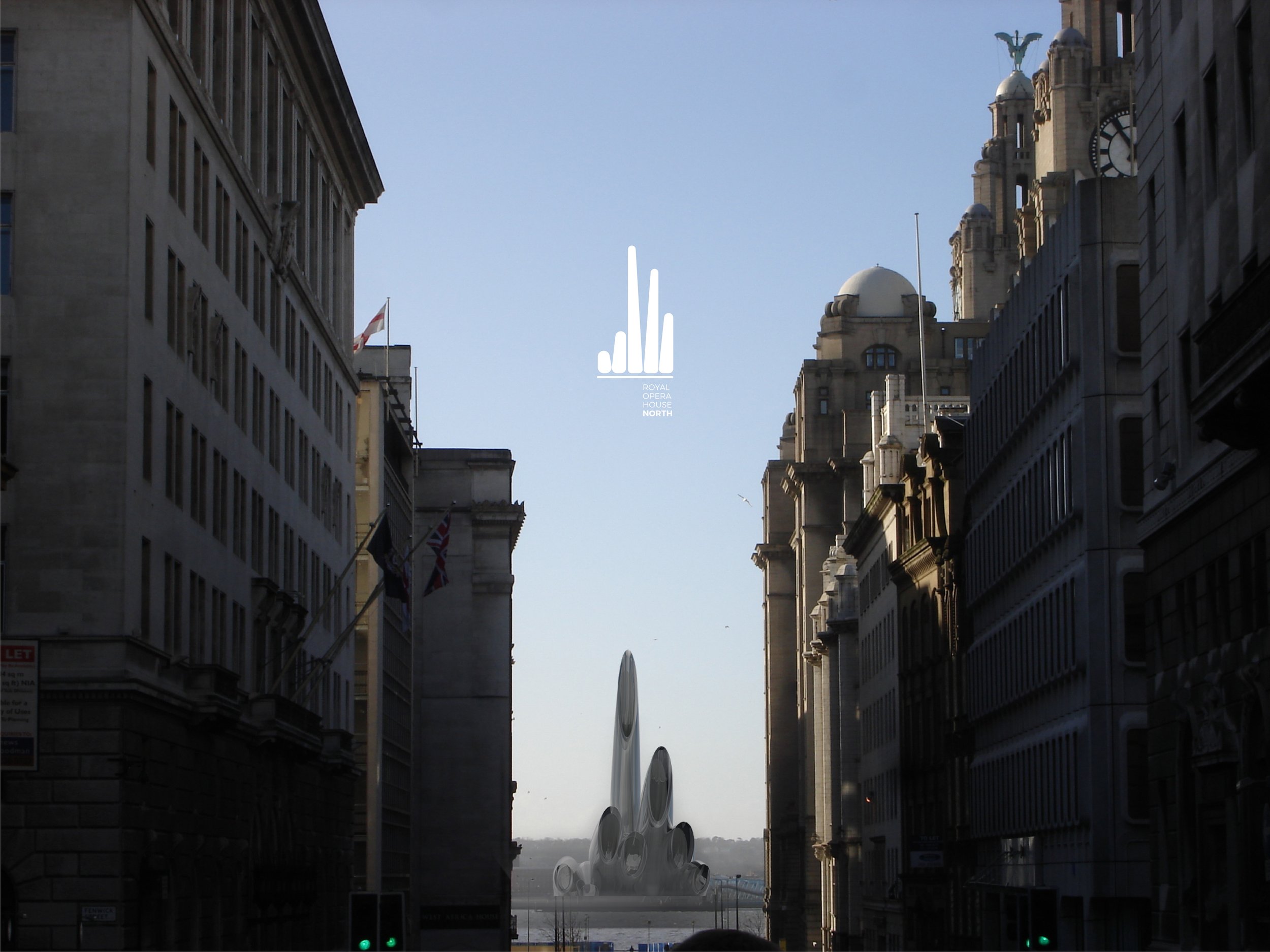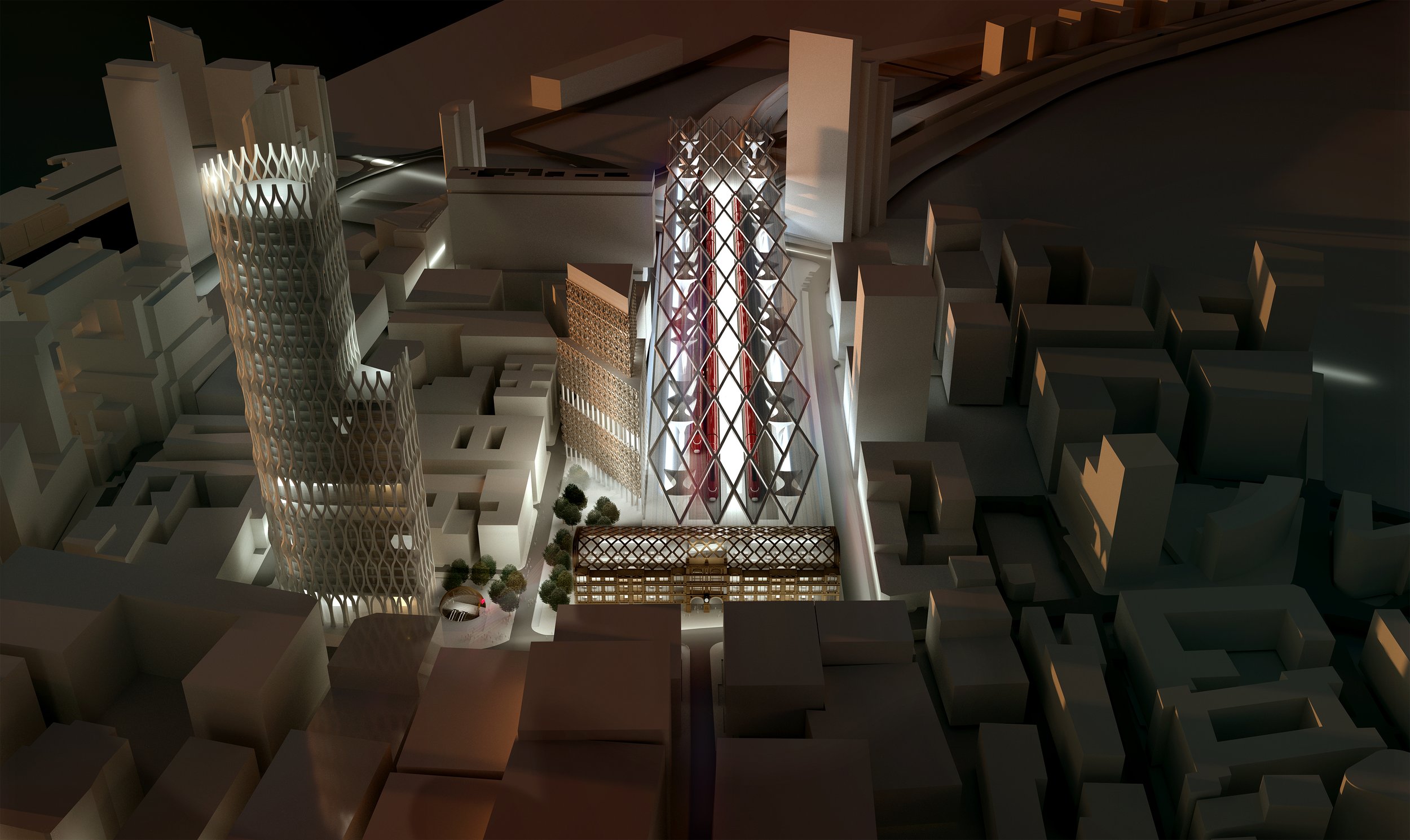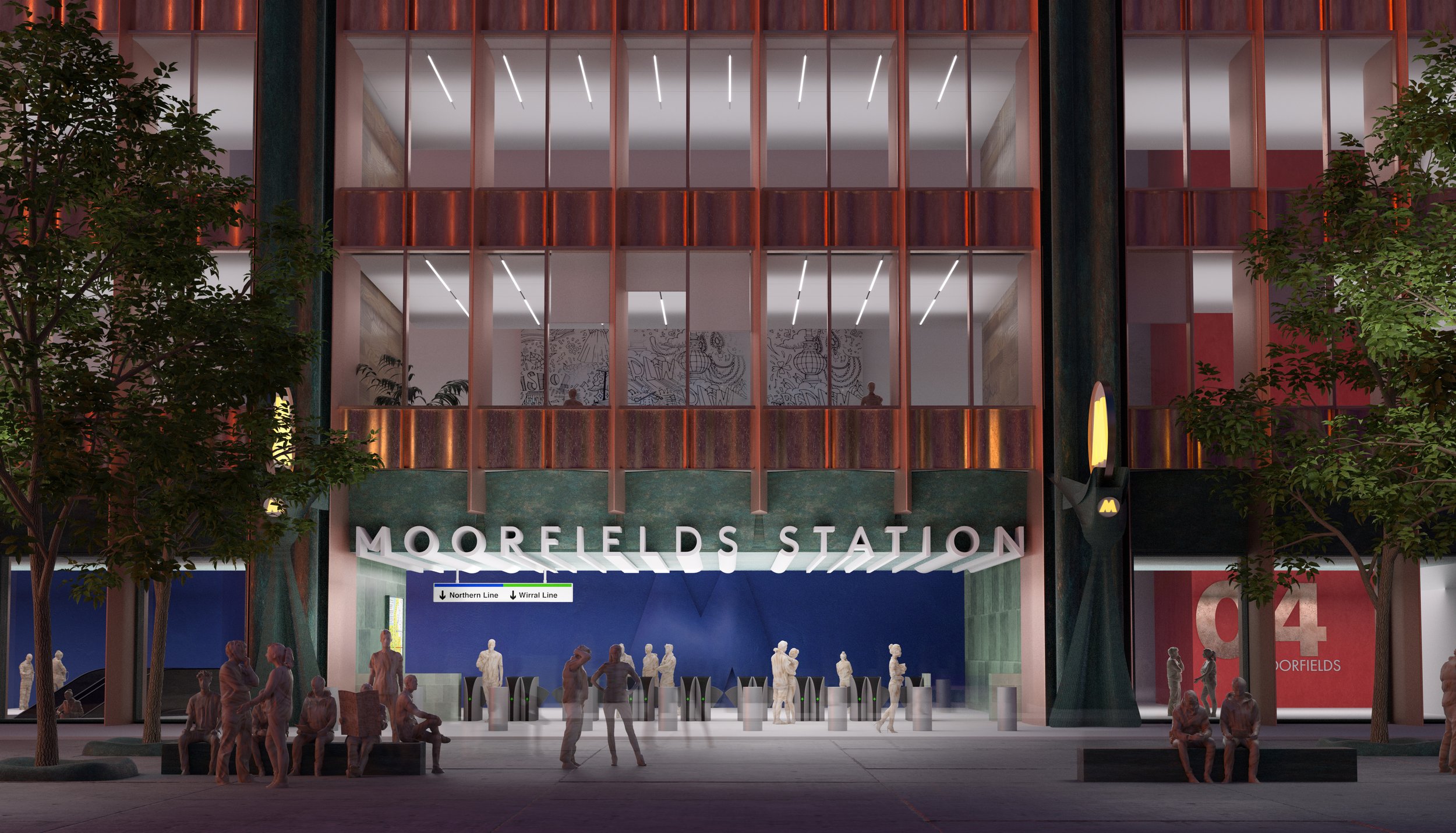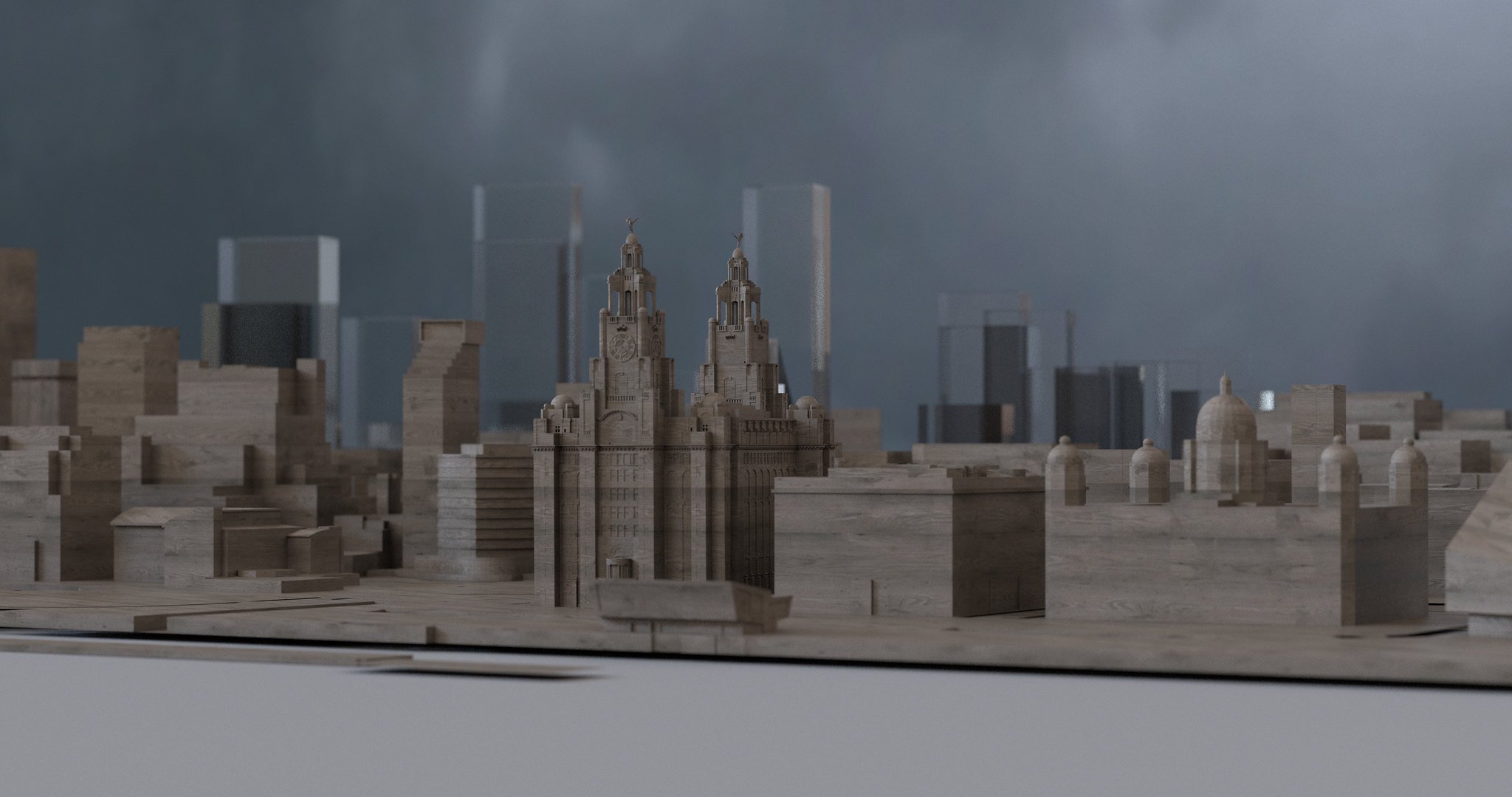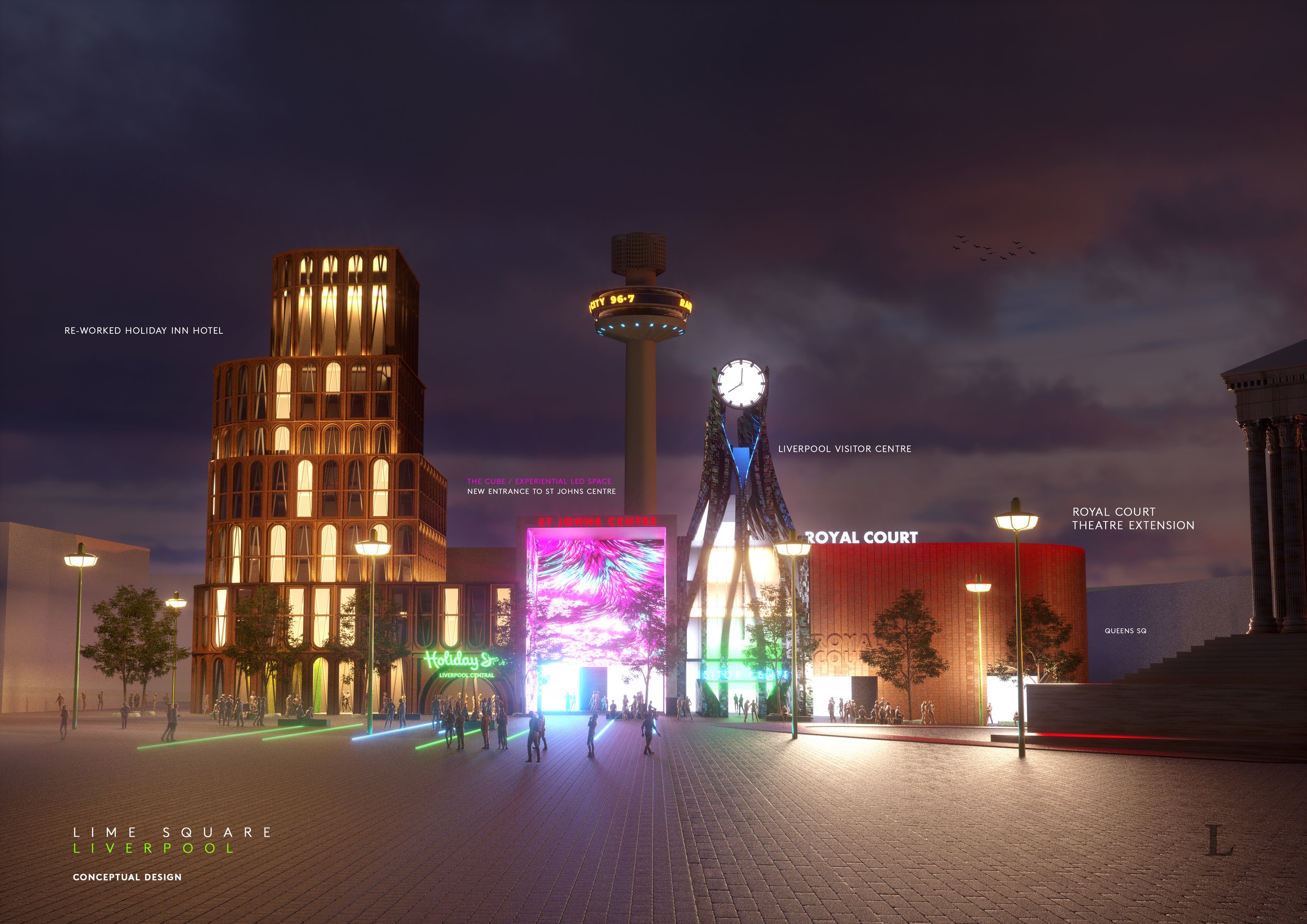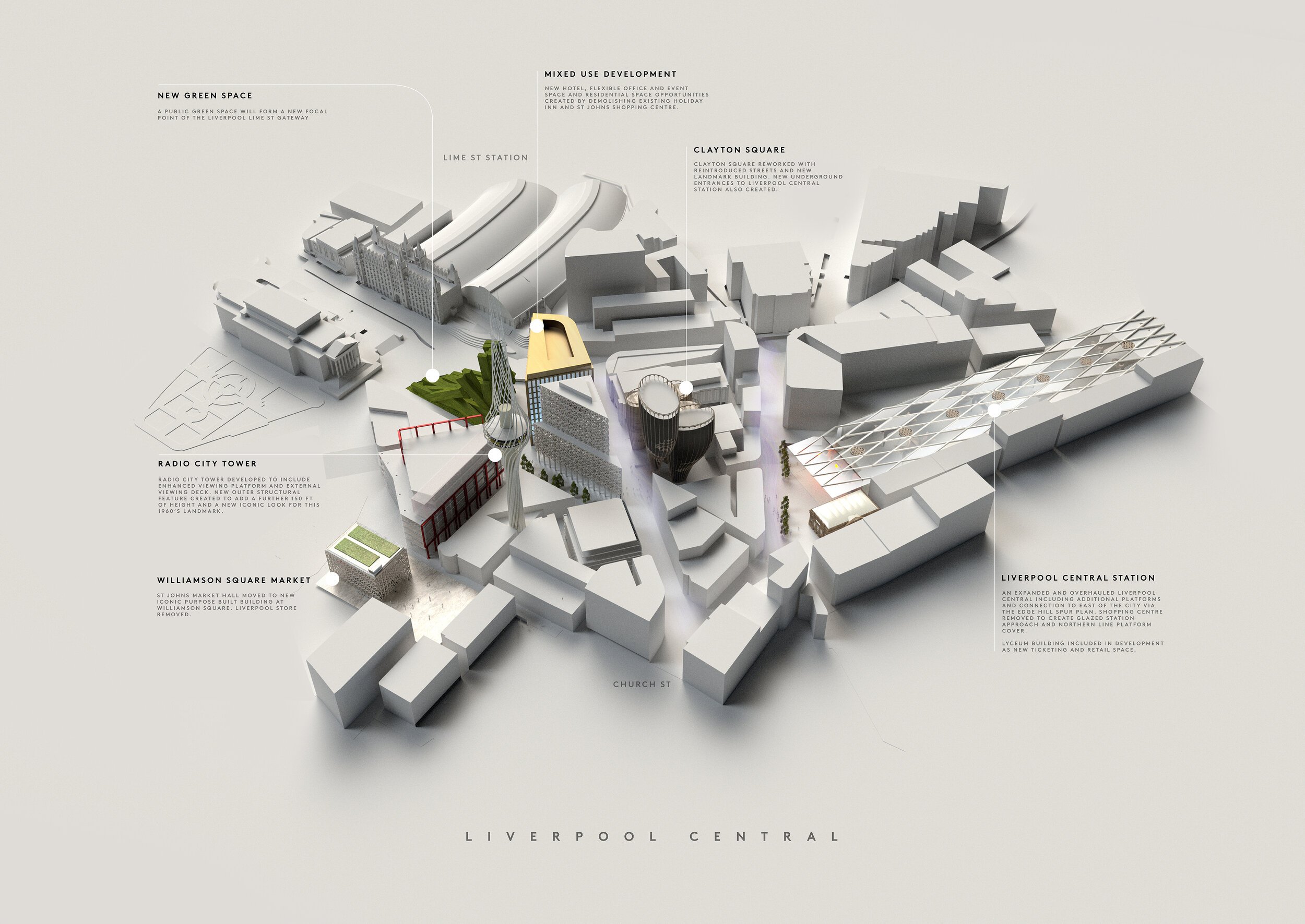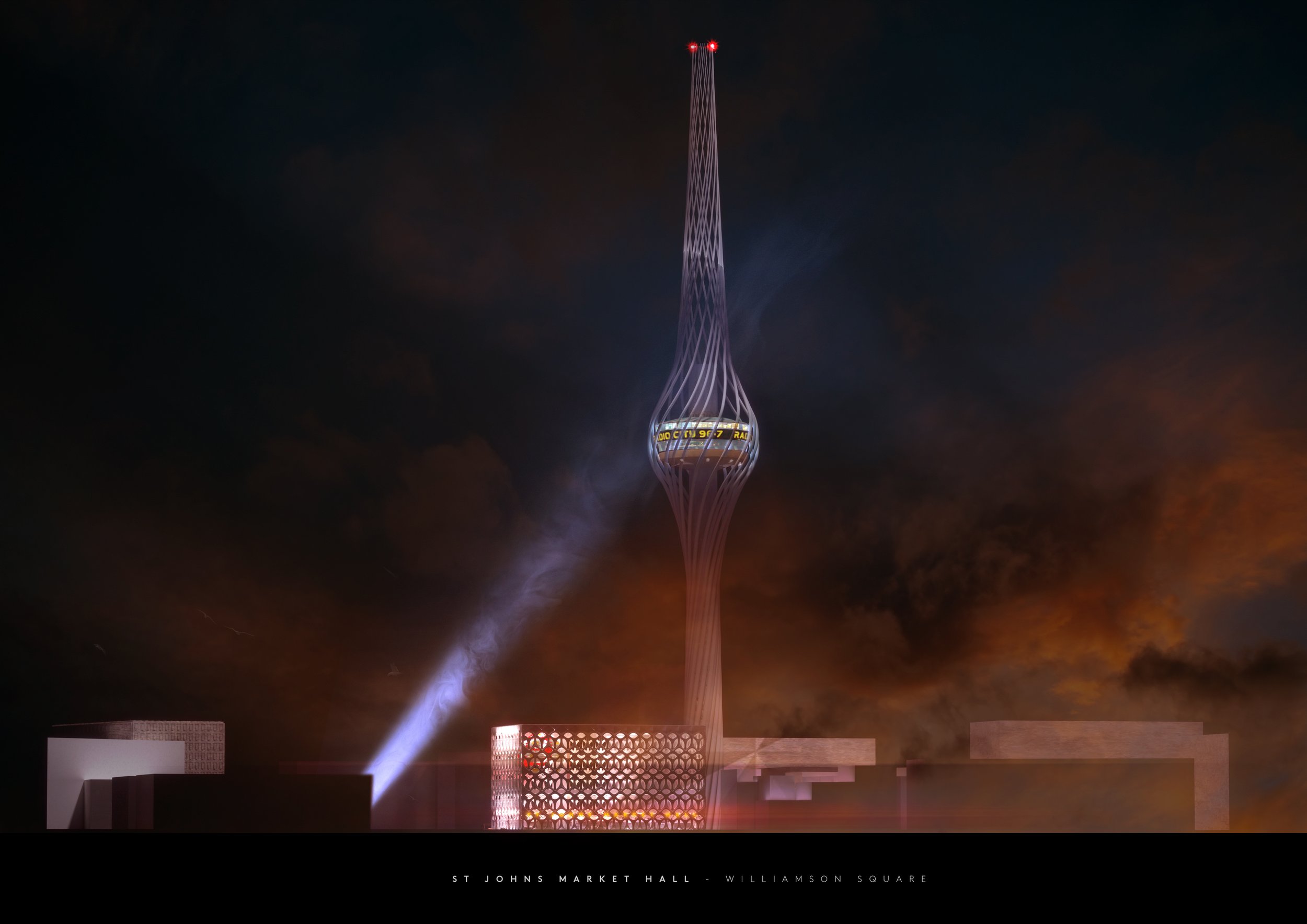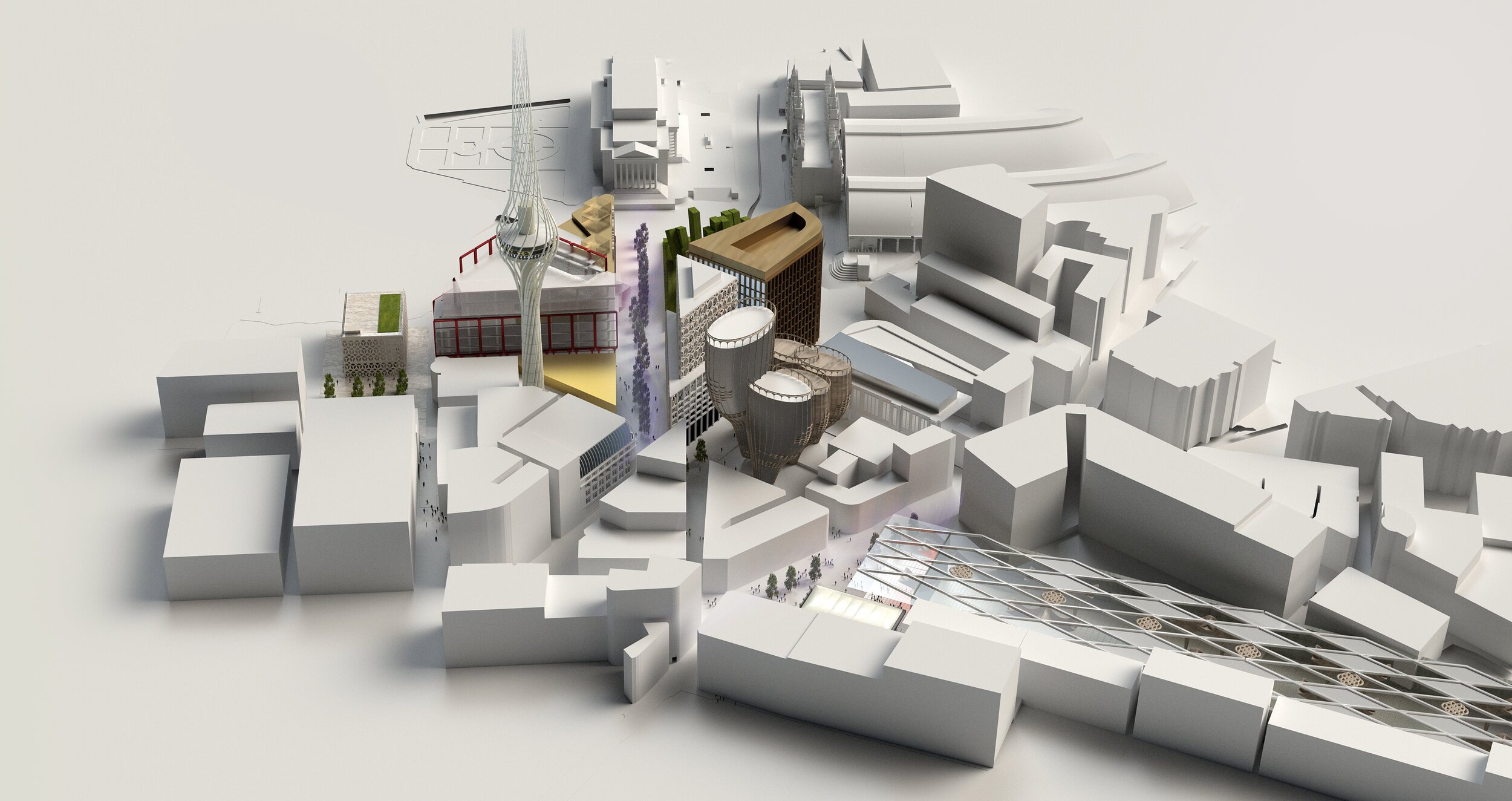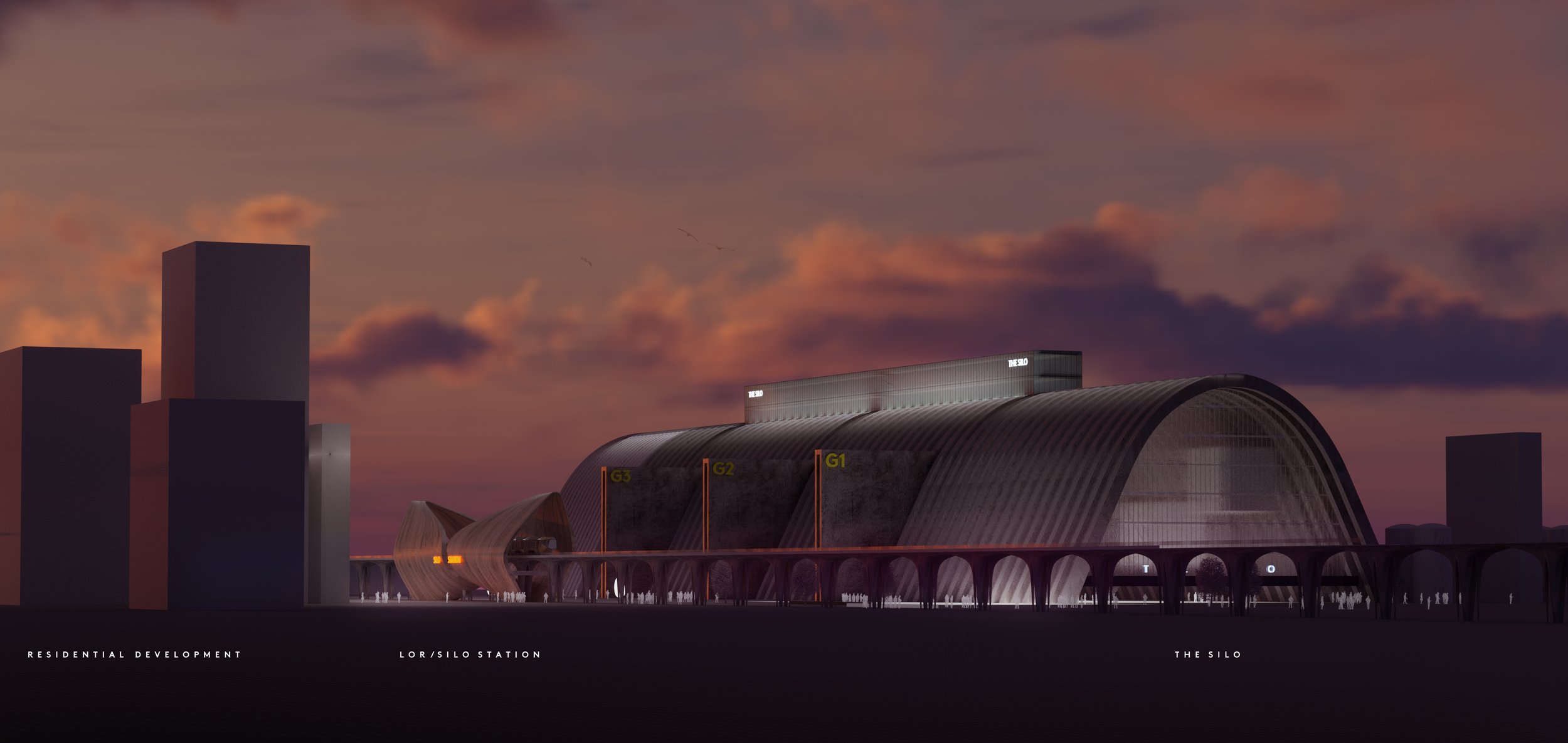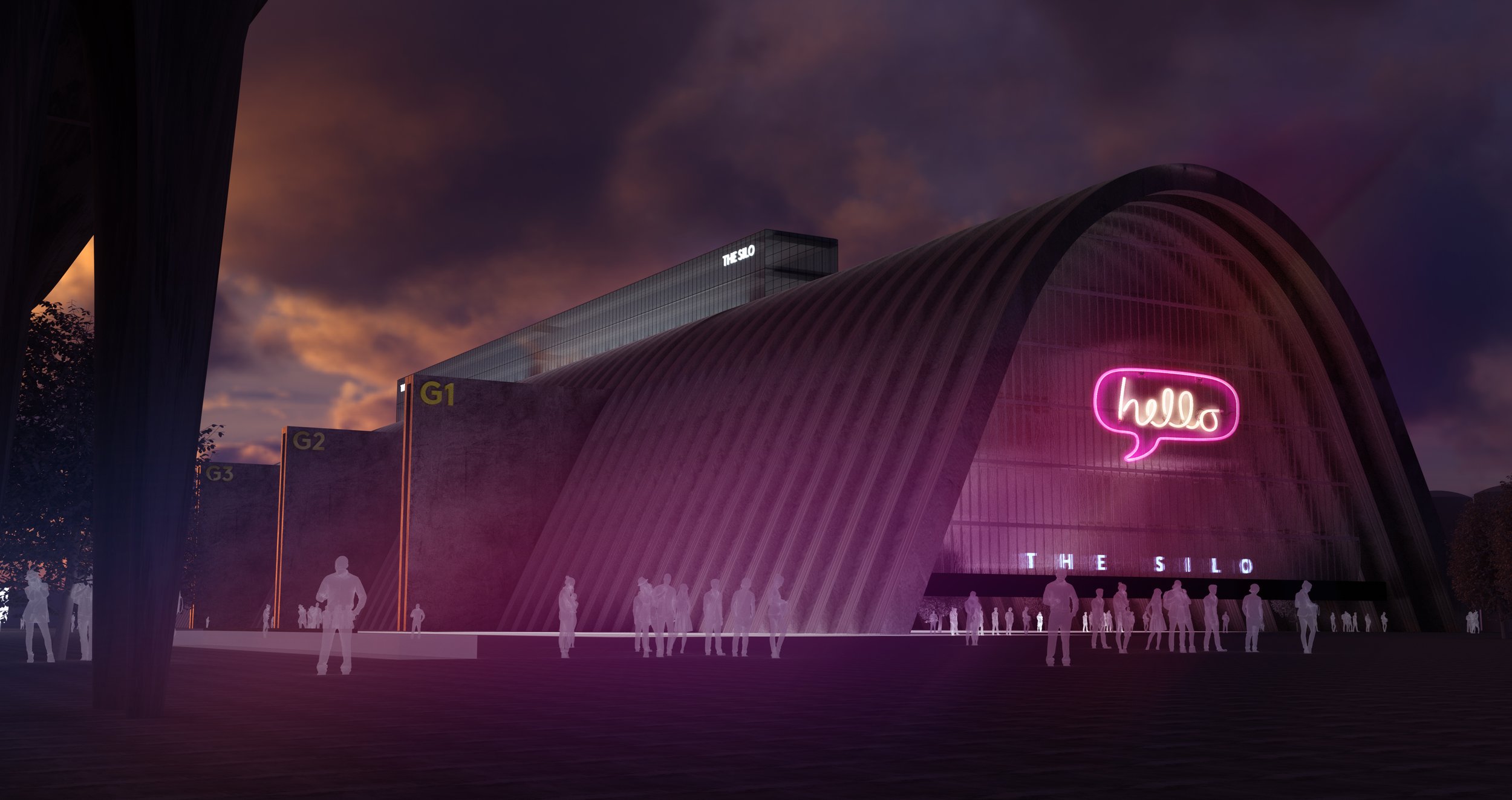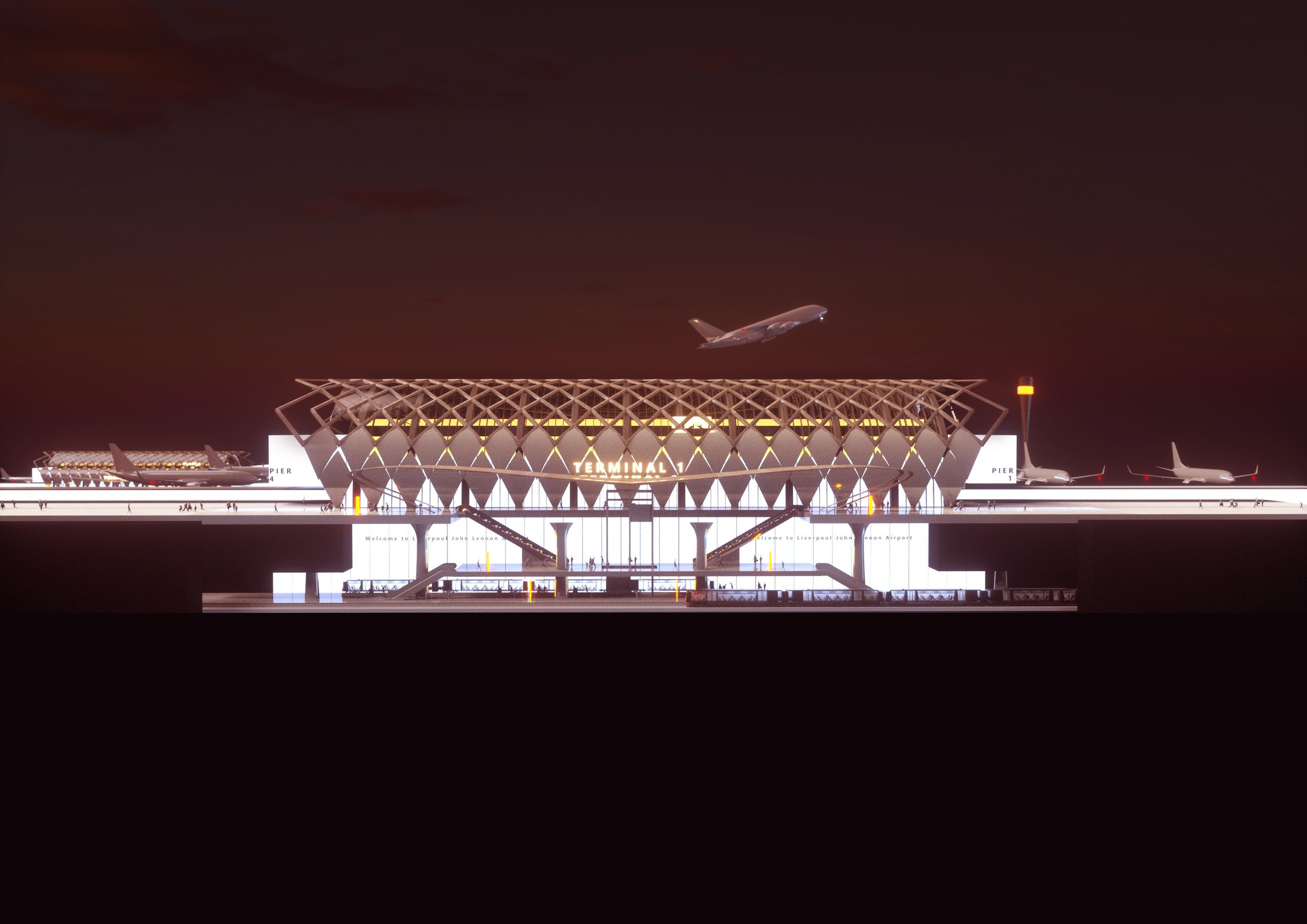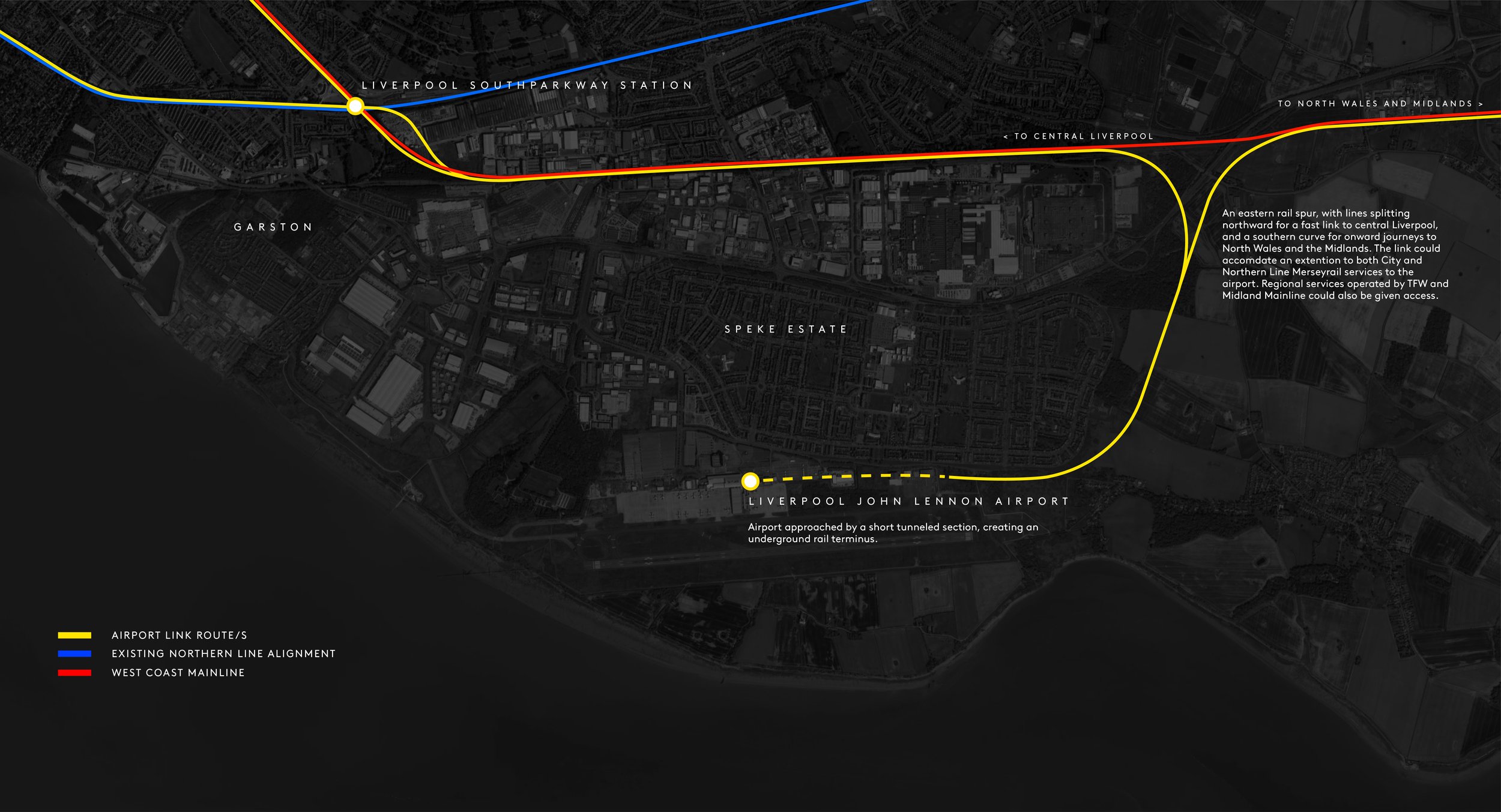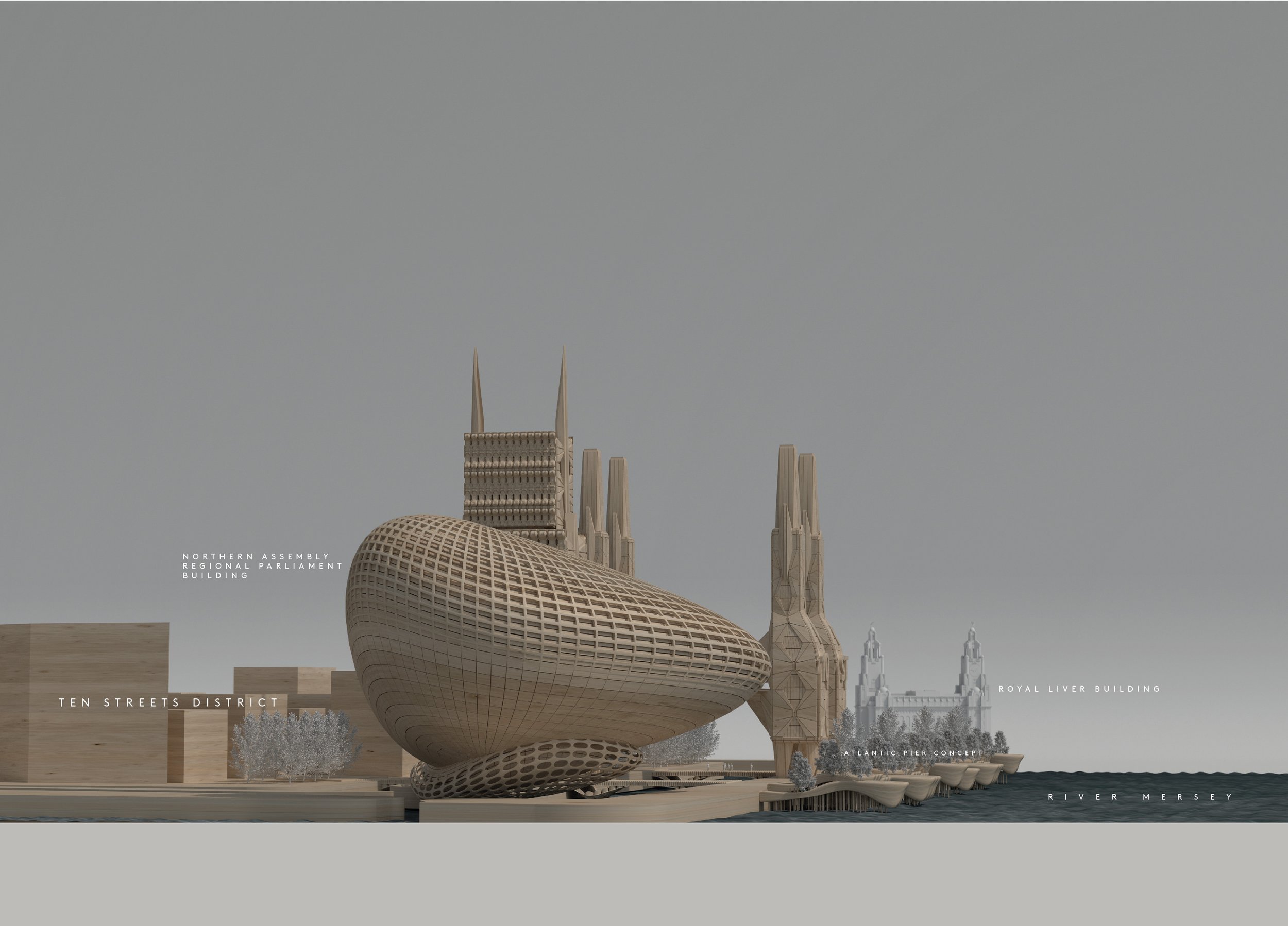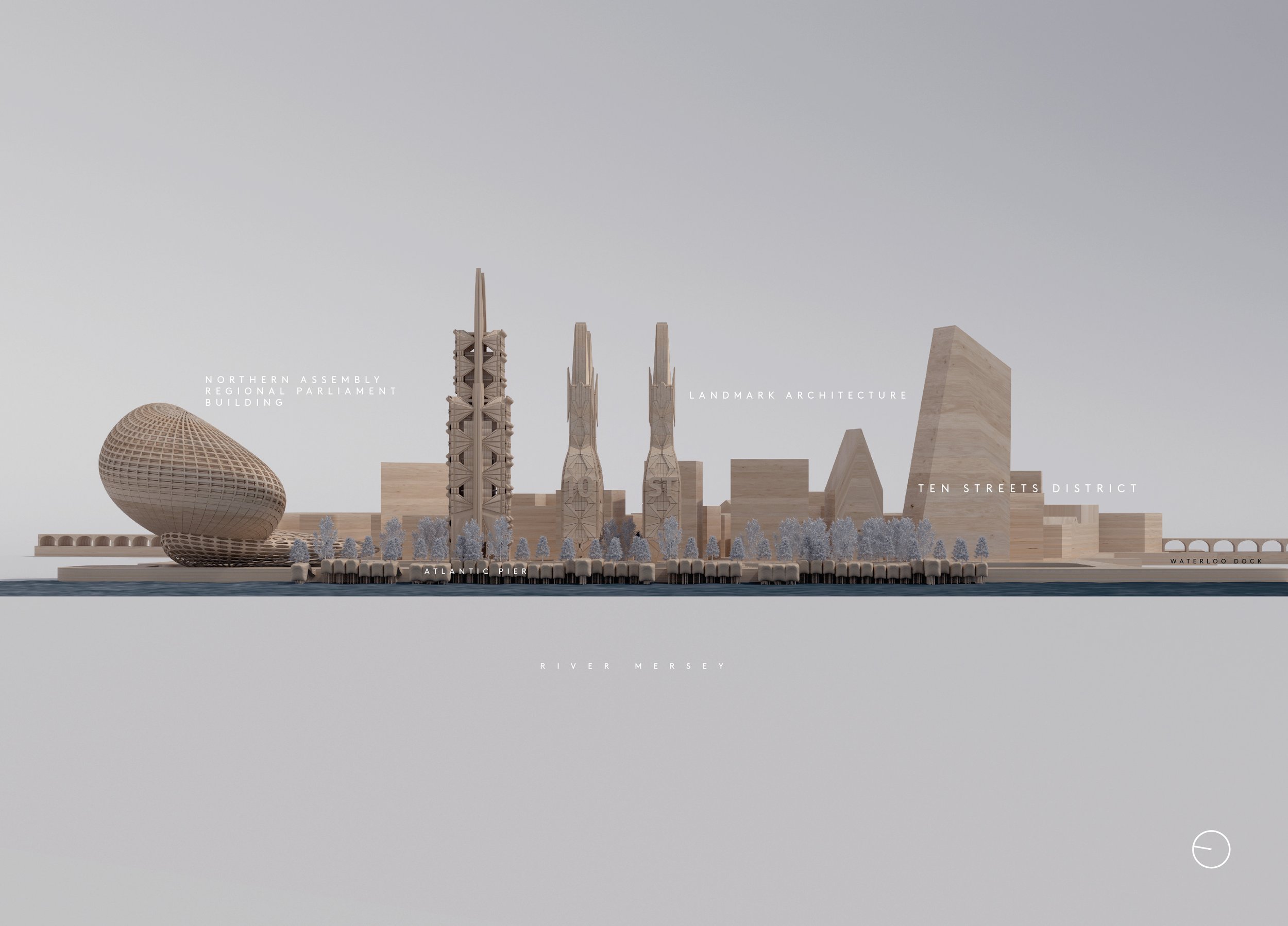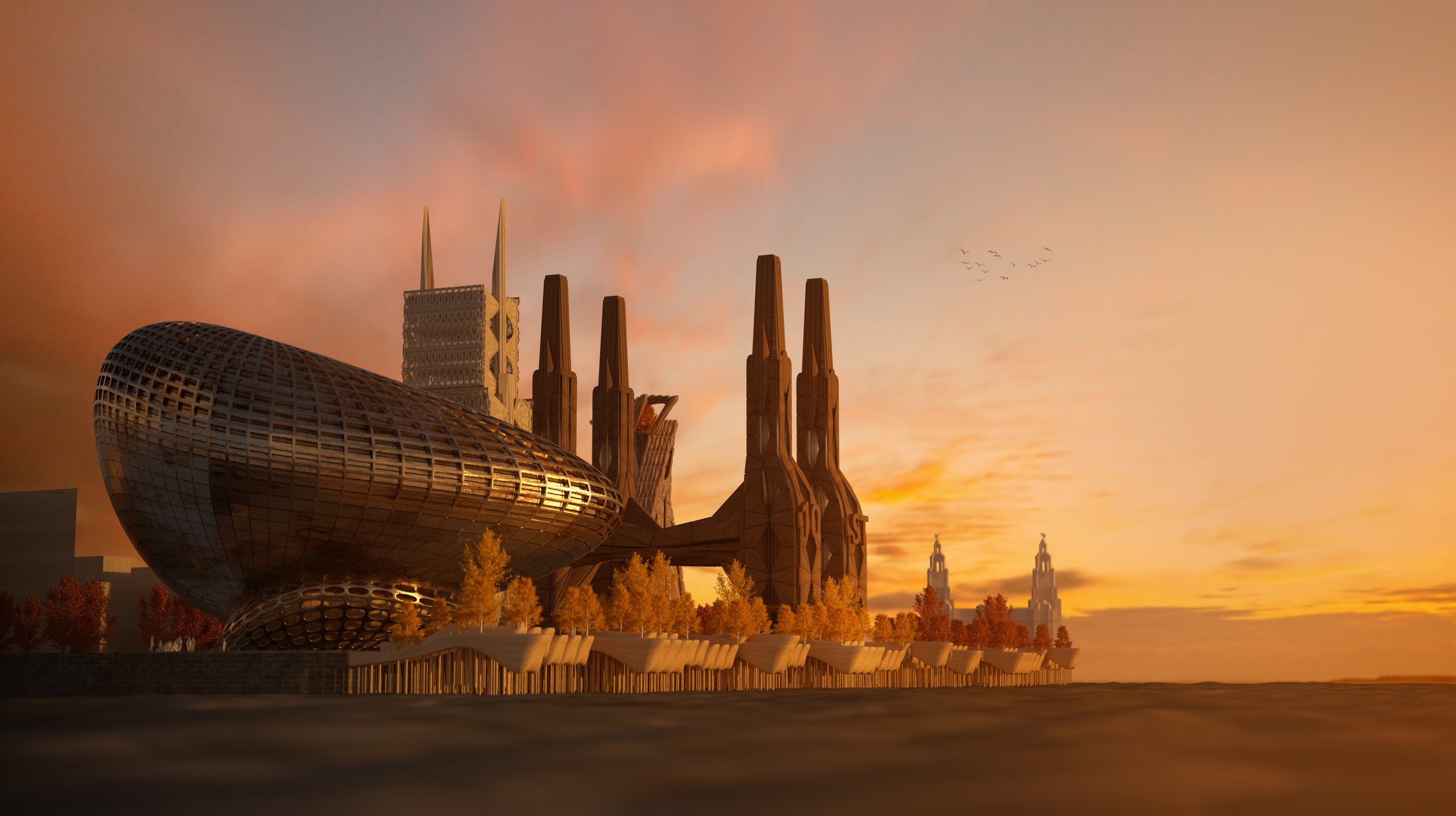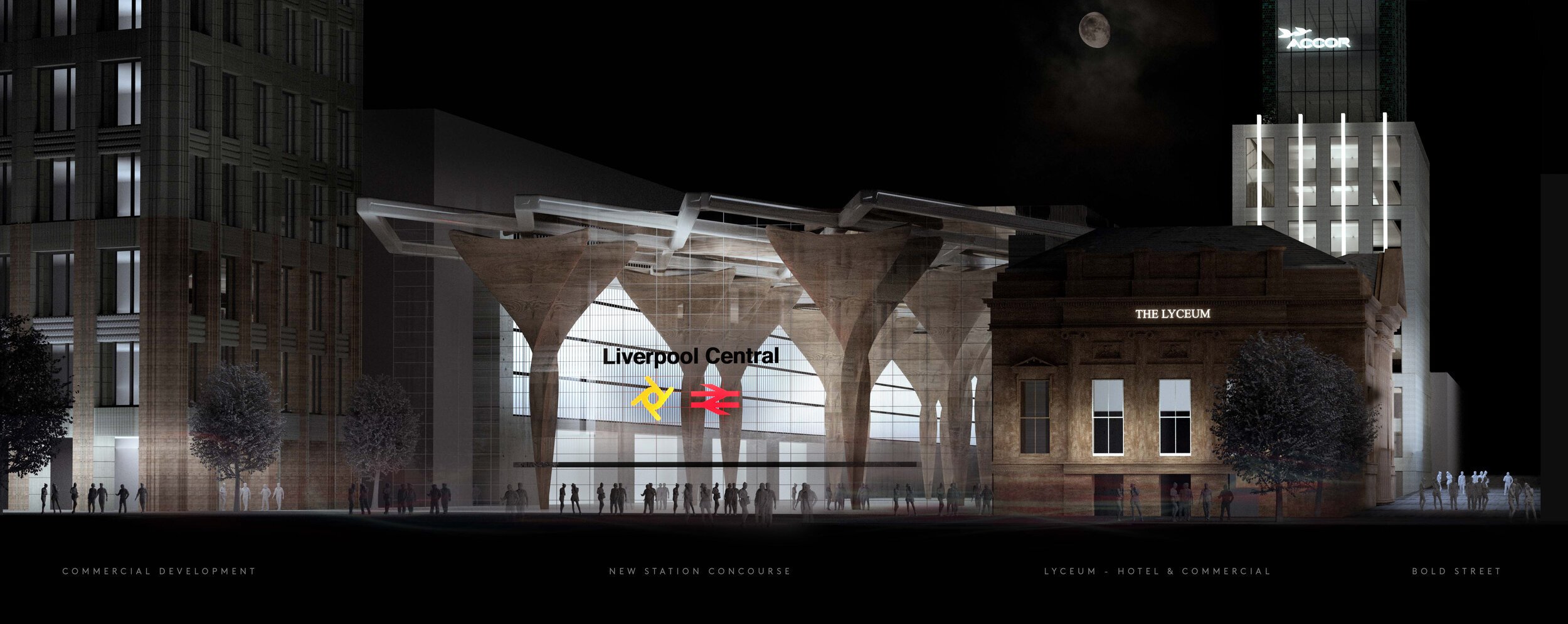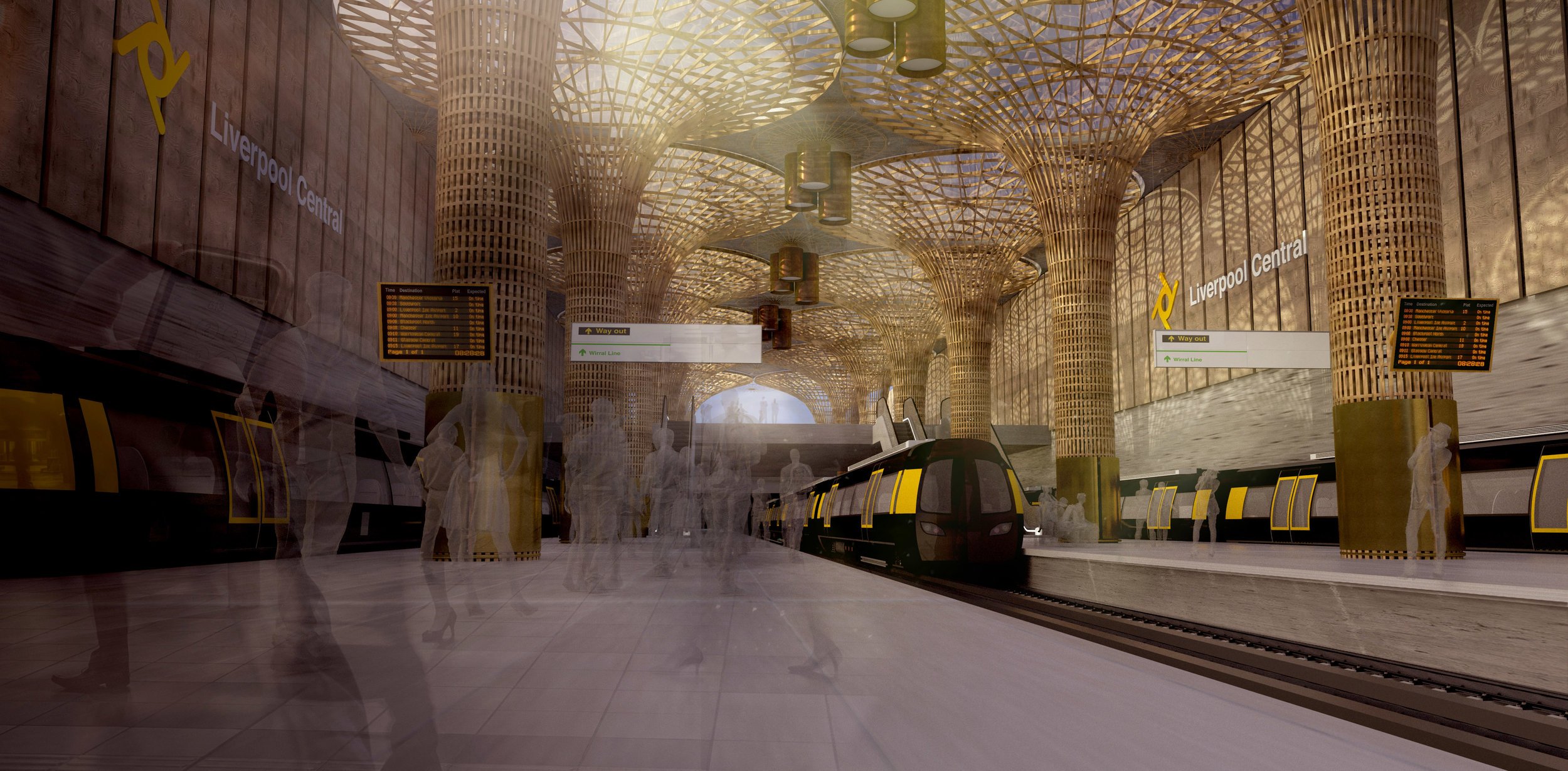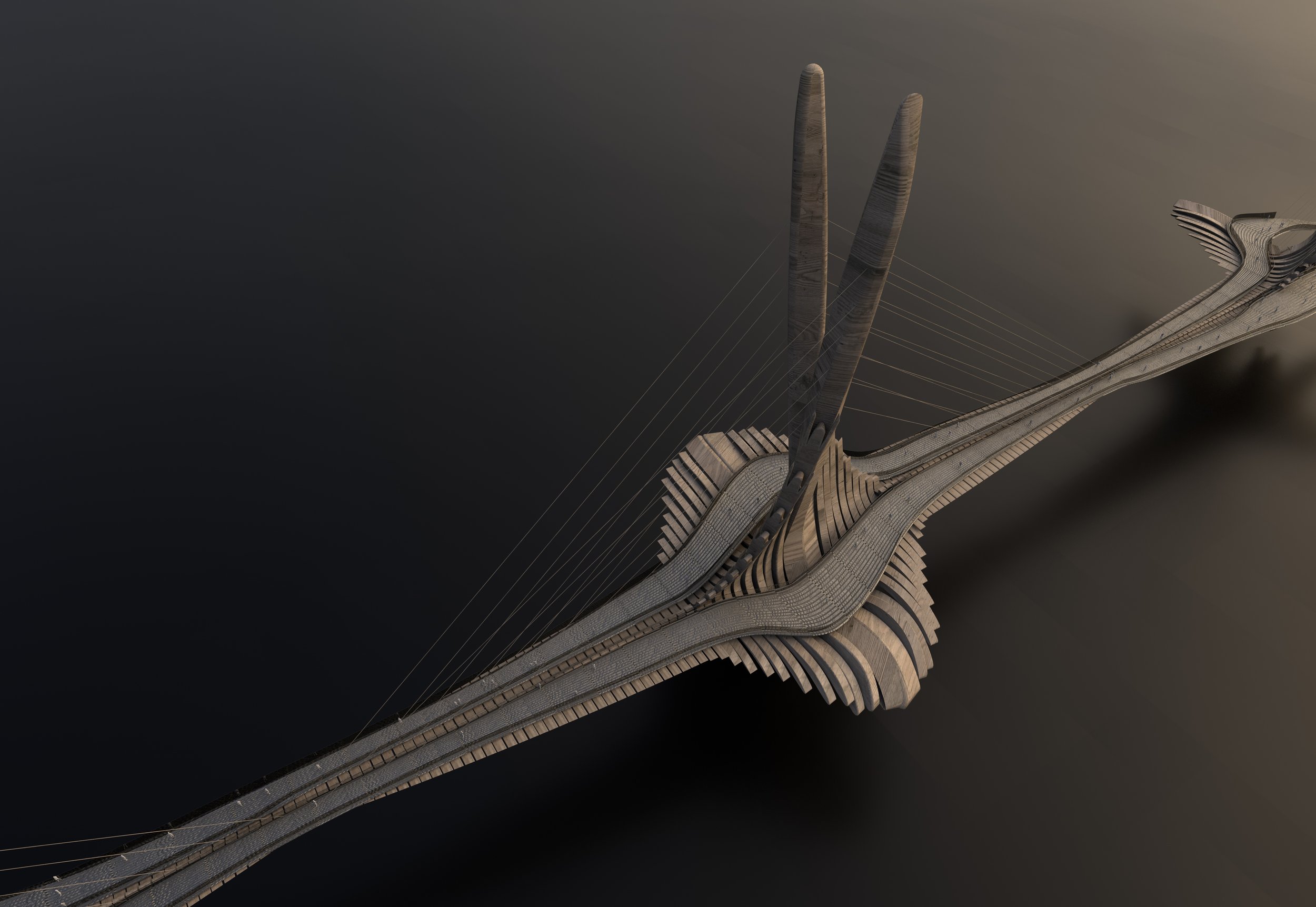Recent features
Ye Wha? Opera on the Mersey and other Mad Visions
For over ten years, 3D animator Michael McDonough, has been dreaming up new ways to re-imagine Liverpool’s urban landscape – designing outlandish opera houses, cathedral-like train stations, gothic bridges, and new visions for the docks. None of them have been built or are ever likely to be. But why does he bother? In this showcase of his work, Liverpolitan Editor, Paul Bryan explores Michael’s fascinating dreamscapes of the imagination.
Paul Bryan
“The way I come at things is to make no small plans. The city has had too much of that, too much dross, too much crap, too much small time thinking.”
So says Michael McDonough, Co-Founder here at Liverpolitan, and a man who has developed a bit of a reputation for his outspoken criticism of Liverpool’s (lack of) development scene. And in fairness, it’s a view that I, as the magazine’s Editor, often share.
One of the things that makes Michael interesting to me (other than the fact he’s had to develop skin as thick as a rhinosaurus to bat off ‘the army of gobshites’ who take him on or even pose as him online) is the fact that despite a successful career as a 3D designer and animator which has taken him to the capital, he continues through his design work to try to make a positive contribution to his home city of Liverpool and the discussion about its future. He does this without fanfare or gratitude and in fact, often in the face of quite complacent criticism from ‘locals’. Often by people with far less talent or insight than himself. For over ten years now, entirely under his own steam, Michael has been dreaming up new ways to re-imagine Liverpool’s urban landscape – designing outlandish opera houses, cathedral-like train stations, gothic bridges, and new visions for the docks. None of them have been built or are ever likely to be. They are not fully formed architectural plans, more dreamscapes of the imagination and we’ve made a showcase of that work in this feature article.
But why does he bother? What’s the point? Aren’t they just castles in the air built before AI and Midjourney made fantastical images the prerogative of all? To believe so would be to miss what’s really going on. There’s a much harder edge lying beneath the glossy visuals. He’s making the case for ambition as an antidote to a city-wide loss of nerve.
“We should be thinking in the same way world cities do like London, Singapore and New York. All these places have big ambitions. We should be looking to emulate that,” says McDonough. Instead, he believes Liverpool increasingly seems resigned to a lower status and too often its mediocre plans reflect that. Small schemes are favoured over transformative ones and then heralded as being the way forward. Anything substantial or showy is typically treated with hostility and suspicion.
“I keep hearing that in Liverpool we’re different, that we have our own models of success, but it’s a language of defeatism, masked and airbrushed as some kind of urban superiority.” He rejects this idea totally. “Being different doesn’t mean you reject ambition, scale and big ideas. That doesn’t make you different, it just makes you stupid.”
‘There’s an obsession in Liverpool’s planning circles with ‘context’ – the idea that new developments must be submissive to the city’s crown jewels."
Michael’s designs are meant in sharp contrast to the veritable cottage industry of ‘place-making’ peddlers, much favoured in recent years by our city leaders, whose low aspiration output chimes with this defeatist mindset. Meanwhile, the same old local architectural practices win job after job, churning out budget off-the-shelf buildings that further erode what makes the city special. There’s an obsession in Liverpool’s planning circles with ‘context’ – the idea that new developments must be submissive to the city’s crown jewels. But that attitude just results in bad buildings and Michael’s designs deliberately shun such restrictions. Some of his designs will inspire, but also enrage.
“The irony,” says McDonough, “is that those buildings we love so much are there purely because of ambition, because of power and commerce. They didn’t just land there as gifts from God.”
The point of history is to learn from it, not to fetishize it. We do Liverpool’s history a disservice by feeble attempts at mimicry. The Liverpool of yesteryear was bolder and more global in its perspective and if we are to take something useful from the past, it should be that. What Michael is attempting to do with these designs is to remind the city that it’s capable of bigger ideas, capable of re-imagining itself, capable of statement architecture, and capable of challenging its city rivals.
“What pushes me to create these designs is a desire to make people see the city differently – and by that I mean primarily the people who live and work within it. Because if we can awaken that boldness of old, so much is possible in our future,” says Michael. That is the lens through which he’d like people to view his designs. Of course, design is subjective. What might be considered beautiful by one person, can be viewed as horrendous by another but he claims to welcome those reactions. “One of our motivations for founding Liverpolitan magazine, was to create a place where thoughts and ideas on the city’s built environment could be shared, discussed and visualised – to think beyond self-constrained limitations,” he concludes. And indeed that is part of our mission.
So buckle in. This is Michael’s contribution. We hope others will be inspired to contribute in the future. It’s a long read. You may need a cup of tea. But there are lots of pretty pictures and food for thought.
Enjoy.
English National Opera, Liverpool
Post-Eurovision, Liverpool emerges with its reputation for hosting big events enhanced and attention inevitably turns to ‘what next?’ So how should the city attempt to capitalise on this positive exposure? Capitalise being the key word here – turning the benefits of a one-off event into something long-lasting, and preferably given a tangible physical form.
Step forward candidate 1: The English National Opera (ENO). This prestigious London-based institution has been told by its funders, Arts Council England, that if it wants the purse strings to remain untied, the institution needs to up-sticks and move to the regions, and rumour has it that Liverpool is very much on the short-list. Some will question why a city like Liverpool needs opera, but even if Tosca and Turandot are not your kind of thing, attracting such a high profile organisation will only add to Liverpool’s cultural offer and open up new job opportunities for young people who might otherwise fly the nest.
Dreaming up a new opera house on the banks of the Mersey, is something that dates back to the wild and unfunded dreams of former Mayor Joe Anderson. But this time, at least in theory, the prospect sounds a little more plausible. Not fully plausible mind – a recent article in The Post claimed the move might be more northern outpost than wholesale relocation, akin to Channel 4’s setup in Leeds. Still, it’s not completely out of the equation – especially if a new facility could combine uses with other functions – education, meeting space, performance arts. Back in 2021, the then-chancellor, Rishi Sunak allocated £2m for a feasibility study into some kind of new immersive music attraction. So despite initial talk of yet another Beatles-focused space, perhaps there’s scope for blending these projects onto one site to make the whole more achievable.
‘The point of history is to learn from it, not to fetishize it. We do Liverpool’s history a disservice by feeble attempts at mimicry.’
The most obvious location is the site of the now defunct former police station headquarters at Canning Place off the Strand. It’s a big site in a glamorous location with the potential to integrate the city centre more closely with the Baltic Triangle. In scale, Michael is proposing a building similar to the much lauded Copenhagen Opera House, which also has a waterfront setting, but he’s keen to avoid any slavish adherence to ‘context’ – “the space is big enough to create its own”, adding new aesthetic design cues to Liverpool’s urban environment rather than forever replicating (usually in impoverished form) what is already there. For Michael, this means “no warehouse-style blocks, no red-brick, and a departure from straight lines.” Some have said they can see a cobra snake in this design and others an elephant (hopefully not of the white variety). “I didn’t intend either but if they’re there, they’re there,” says Michael. “It’s all about organic, smooth, natural forms.” The final two images in the set, which show the interior of the main auditorium, were created using artificial intelligence more as an experiment in what is possible with the technology.
As an added bonus, Michael is proposing to demolish the John Lewis car park, which adds a “blocky barrier to the growth of the city centre eastwards,” as well as eroding the sense of occasion that this landmark structure deserves. A new solution would have to be found for the bus depot that sits beneath it (not to be confused with the Paradise Street Bus Station which would remain unaffected).




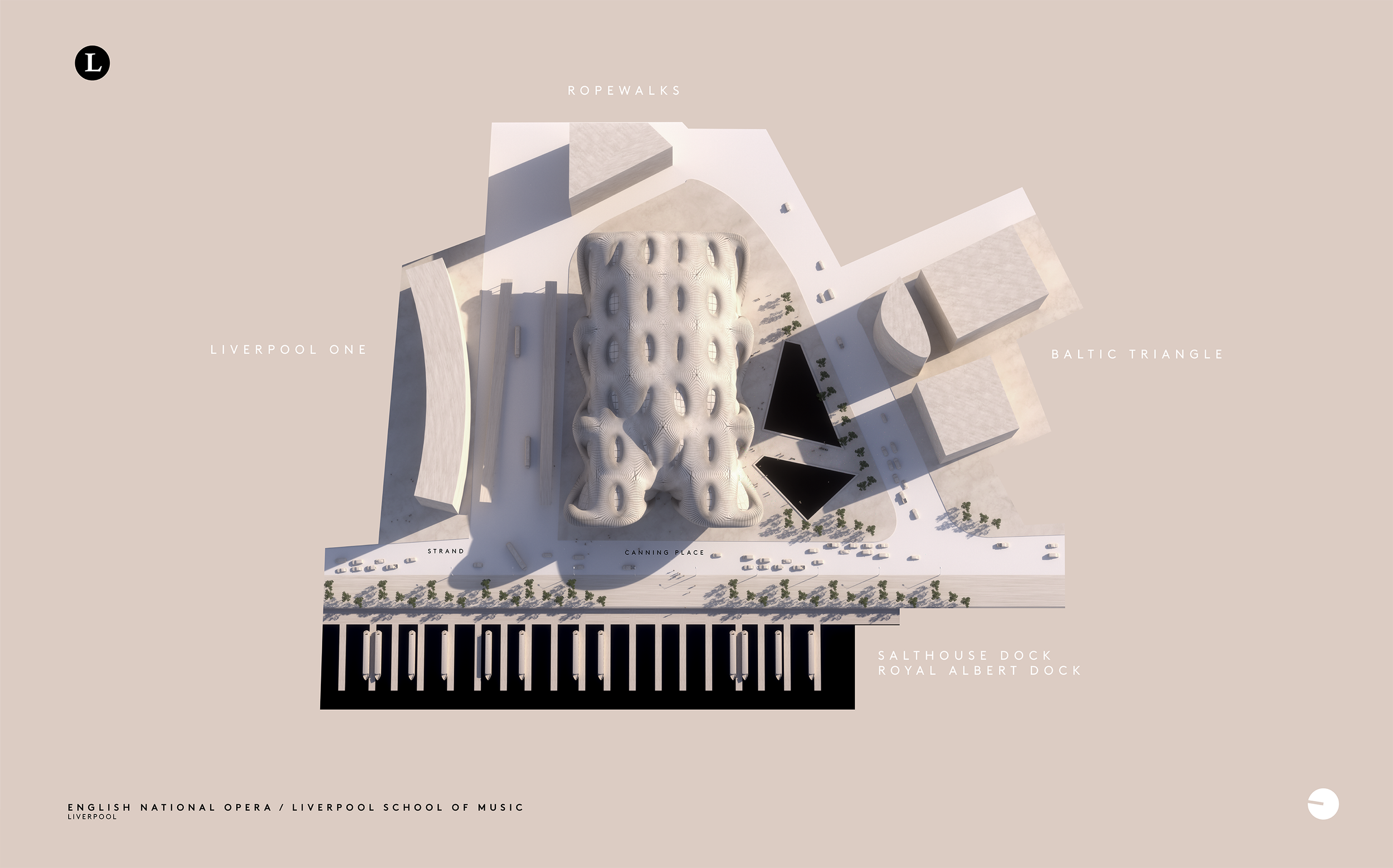
Liverpool Overhead Railway
Many people have long been fascinated by the Liverpool Overhead railway and perplexed by its loss. Extending seven miles along the length of the city’s impressive docklands from Seaforth and Litherland in the north to the Dingle in the south, the line survived for just 64 years before the decline in dock employment ate too deeply into its commuter base. There can be little doubt that if the Overhead Railway had survived into the modern era instead of being dismantled in 1956-57, it would have become another iconic symbol of Liverpool reminiscent of the Chicago ‘L’ trains. Not only that, but it may have long ago expedited the regeneration of the north docks into other uses. Instead, minus viable transport provision, we have had to watch on powerless as docks have lain derelict for decades under the tattered banner of Liverpool Waters.
As much as it’s fun to sit within an old Overhead carriage within the Liverpool Museum (and marvel at its spacious dimensions and varnished wooden interiors), Michael would much prefer to see it rebuilt. The case is becoming stronger with the soon to open Bramley Moore Dock Stadium, the Titanic Hotel and new apartments in the Tobacco warehouse extending the city centre and creating a line of activity to the attractions centred around the Albert Dock.
‘The Liverpool Overhead Railway may have long ago expedited the regeneration of the north docks into other uses. Instead, minus viable transport provision, we have had to watch on powerless as docks have lain derelict for decades under the tattered banner of Liverpool Waters.’
However, Michael says “we cannot and should not merely recreate a pastiche of the old line.” Technology and engineering have moved on, and the old structure was difficult and expensive to maintain. Besides, its heavy-set viaducts blocked views of the river from further inland, which might be unwelcome today. If the city are ever to rebuild the Liverpool Overhead Railway, he feels it should “celebrate the past but not be beholden to it.” A little like London’s Docklands Light Railway (DLR), his version 2.0 is a fully-fledged railway, not a monorail, elevated by organic and elegant concrete columns that avoid the blocky and very nineties form of the DLR design.
To maximise its utility, Michael’s new Liverpool Overhead Railway would not simply follow the old route but would connect more widely. Starting at Bootle in the north to better integrate that area as part of our metropolis, the line would connect the Everton stadium and key attractions centred around the Albert Dock before heading off south to the airport, and perhaps also east via the disused Waterloo or Victoria tunnels. The design of the structure would be modern, and the trains capable of running on conventional tracks (like the recently introduced Merseyrail ones) opening up options for integration with the wider rail network.
Royal Opera House North & Wirral Cultural Centre
At Liverpolitan, we’ve always believed the Wirral Waterfront to be Liverpool’s great missed opportunity. Overlooking one of the finest riverside vistas in the world, the left bank of the Mersey should be prime real estate, and yet it’s almost apologetically unimpressive – as if frightened to upstage its more famous brother. Surely, we can do better? “People laughed at the idea of Salford Quays hosting the BBC and the Imperial War Museum North,” says Michael, “but with its spectacular setting, the Wirral Waterfront should be aiming higher again.”
Two waterfronts, one city has to be the future but to really make that idea count, at some point we’ll need a significant intervention in the landscape. Wirral Council are doing good work in master planning a new Birkenhead with a better relationship to the river and Liverpolitan is all for it. But to seal the deal, argues Michael, “the Wirral needs something that stands out, something that can be seen from the Liverpool side – something that says ‘Look at me, come over to the Left Bank.’”
Given the 0.7 mile width of the Mersey between Liverpool and Birkenhead, any new landmark structure would need to be huge, gargantuan even. Taller than the 210 feet Ventilation Tower. Possibly taller than the 328 feet Radio City Tower. Cathedral-like in scale and presence. It was along those lines that McDonough put forward this earlier concept for a Royal Opera House North – aligned so that “you can see it as you look down Water Street – the two sides of the river visually connected with an iconic landmark; a catalyst for seeing Birkenhead through new eyes.”
The design is dominated by a series of steel funnels with a glinting chrome façade pointing in all directions of the compass including skyward. They would be wrapped around a central auditorium which could also have uses as a cultural centre exploring the Wirral’s fascinating history from the Vikings to its use as a monastic retreat, not to mention shipbuilding and its colourful background as a smugglers paradise.
‘The Wirral needs something that stands out, something that can be seen from the Liverpool side – that says ‘Look at me, come over to the Left Bank.’
Liverpool HS2
It’s all gone a bit quiet on the High Speed 2 railway project hasn’t it? Maybe that’s a good thing – just get on and build it. But for Liverpolitan, HS2 has always been something of a poker-tell, not so much about the lack of commitment of the national government to invest anywhere outside of the south – which to be honest, we can all take for granted. No, what HS2 really reveals in full technicolour is the shallowness of Northern solidarity – some places, most notably Manchester and Leeds are consistently favoured over others like Liverpool and Newcastle. Despite the sweet words of ‘King of the North’, Andy Burnham, arguments about agglomeration are forever used to draw money and opportunity towards these investment blackholes and away from everywhere else. And HS2 has been the smoking gun. More’s the pity that Liverpool’s own leaders have been too foolish to notice (or they never cared).
When the Conservative government announced the Integrated Rail Plan for the North and Midlands in late 2021, the media was full of a wailing and gnashing of teeth. Cutting HS2’s eastern leg to Leeds and scaling back plans for Northern Powerhouse Rail was seen as more evidence of the perfidiousness of London and Whitehall. Right on cue, Liverpool’s often hapless Metro Major Steve Rotheram, joined in the venting, complaining that “we were promised Grand Designs, but we’ve had to settle for 60 Minute Make Over.”
Not for the first time, a fair reflection of Liverpool’s own particular interests was absent, but with the help of railway campaigners like Martin Sloman and Andrew Morris of 20 Miles More, Liverpolitan spotted it. The truth was, the plan might have been less good for Leeds and Manchester but it was better for Liverpool. Fresh high speed track was going to be laid closer to the city in a dedicated spur that would relieve capacity constraints and increase the scope for an expansion in freight services. In addition, the need to widen the narrow throat entrance to Lime Street was also finally acknowledged. Hurrah!
‘What HS2 really reveals in full technicolour is the shallowness of Northern solidarity – some places, most notably Manchester and Leeds are consistently favoured over others like Liverpool and Newcastle.’
Still, wanting the best for Liverpool means building new track all the way into the city centre serviced by a full specification HS2 station. By the way, what happened to the commission set up by Steve Rotheram in March 2019 and announced with full fanfare at the MIPIM Property Exhibition, which chaired by Everton CEO Denise Barrett-Baxendale, was going to choose between 2 possible locations for a new “architecturally stunning” HS2 station in the city centre as well as 5 routes in for the track? Quietly dropped?
Focusing on the most likely outcome of a redeveloped Liverpool Lime Street, Michael has put together some outline designs, which incorporated the grade-II listed Radisson Red Hotel (previously the North Western Hotel) as the main entrance to the station.
To read Liverpolitan’s cutting dissection of HS2 and the Integrated Rail Plan for the North and Midlands, check out ‘HS2 – A Liverpool Coup?’ by Michael McDonough and Paul Bryan
Or to read Martin Sloman’s examination into the options for a city centre station, try ‘Lime Street or Bust? The Options For Liverpool’s HS2 Station’
Moorfields and the Commercial District
Back in March 2023, Liverpolitan tweeted about the state of Moorfields, which we described as “a regrettable symbol of Liverpool's down at heel CBD.” We noted that the area is littered with dereliction, empty office buildings and signs of homelessness, and asked the question, “Have we become so used to this embarrassing patch that we no longer see it as failure?”
The tweet received almost 45,000 views and provoked a whole host of online conversation with the issue later picked up by the Liverpool Echo. Councillor Nick Small, who after the recent local elections is now the city’s Cabinet Member For Growth and the Economy, got involved, agreeing that the site needs to be developed. There was some discussion about whether robust plans for the area were in place already as part of the City Centre Local Plan and Strategic Investment Frameworks (SIFs). But mostly, to the extent that the local BID or the Council have acknowledged the issue, action on the ground seems in short supply.
To some extent, the lack of regeneration may be an issue of plot owners sitting on parcels of land and waiting for a payday, but as a subsequent squabble between Merseyrail and the Council over who was responsible for cleaning the grotty Moorfields escalator showed, a lack of concerted coordination between agencies leaves ample scope for things to fall between the cracks.
Moorfields is littered with dereliction, empty office buildings and signs of homelessness. Have we become so used to this embarrassing patch that we no longer see it as failure?
Michael McDonough argues that Moorfields is another of Liverpool’s great missed opportunities and it’s hard to disagree. The area’s city centre location, great transport links, and historic setting within the traditional heart of Liverpool commerce, should with the right support, allow it to live again. “The whole area needs re-invention and the drift towards noisy bars and tourism serves to cheapen its prospects,” says Michael. He claims that demolishing the rotten Yates Wine Lodge should just be the start. “Moorfields can handle density and scale and is the perfect place to rebuild Liverpool’s grade-A office offer” centred around the idea of prestige and talent.
In these visuals, Michael wanted to rebuild the entrance to Moorfields Station with mid-rise commercial office space above – no more going up to go down. He also took a stab at upgrading the former Exchange Station offices, which “may have been grand from the front, but from the rear leave a lot to be desired” – failing to properly address the park that will hopefully one day be re-instated as part of new public realm within the wider Pall Mall development.
St Johns and Central Liverpool
Far, far and away McDonough’s biggest bugbear with Liverpool’s built environment has to the St Johns Shopping Centre. We know it’s commercially successful and last time we looked it had a 97% retail occupancy rate. It clearly fills an important niche within the city’s shopping offer with its cheaper rents for retailers. But damn if isn’t an ugly pig of a building (no offence to our porcine brethren). Arriving at Liverpool Lime Street, that’s the first thing you see. Talk about first impressions. Squatting over a network of old streets and the site of what would be today, if it hadn’t been bulldozed, a much valued Victorian market, Michael believes St Johns is a “dated lump of a building that acts as a physical and psychological barrier between London Road and the rest of the city centre.” It’s not a stretch to suggest that St Johns has played a role in the former’s decline. Repeated, half-hearted attempts to patch the shopping centre up have failed and its blue plastic blanket and struggling traders’ market are a testament to “a succession of bad planning decisions going back fifty plus years.” A lasting solution to all of these problems, says Michael, “requires demolition.”
The images Michael has put together here are a collection of different attempts to reinvent this “ugly and misfiring section of Liverpool.” The main driving force behind his designs is a desire to remove this “lumpen barrier” and re-stitch together our centre “in a more permeable way that evokes expressions of pride rather than cringes.” Michael wants to see a much better front door to Liverpool Lime Street – our city’s once grand hello and goodbye point. He’d like to replace this “parody of the city’s greatness” with something more iconic and ambitious.
‘St Johns is a dated lump of a building, its blue plastic blanket and struggling traders’ market a testament to a succession of bad planning decisions going back fifty plus years.’
The eagle-eyed might spot the use of neon and a prominent clock tower as a modernised callback to what the site has lost. As Michael says, “we can’t always recreate the past but we can be inspired by its best bits.” He’s also given the Grade 2-listed but still a bit ugly, Radio City Tower, a makeover, adding an elegant polished steel lattice of radiating lines which add height, fluidity and tricks of light to recast a regional landmark into one of world significance.
Read more about Michael McDonough’s vision for St Johns in the Liverpolitan feature, A New Central Liverpool.
The Silo
The former grain silo in the north docks is one of Liverpolitan’s favourite buildings in Liverpool. If it was just a little further south, closer to the Tobacco warehouse and Bramley Moore, we could imagine it being repurposed as a truly iconic, high capacity arts, events and business hub. However, the silo is located deep within the working part of the dock estate with industrial infrastructure all around it, so that idea is likely to remain a dream. Still, just imagine what could be done with this incredible structure. For McDonough, the project would “represent a development challenge similar to how London’s Bankside Power Station was transformed into the Tate Modern.”
For these visuals, Michael has re-imagined the space as a media industry hub – with film, TV and radio studios and education space for our universities – “a back-up plan in case the Littlewoods Film Project doesn’t deliver.” There would also be a theatre venue, gallery space and office facilities for the production sector – which he describes as “the perfect tonic to act as a catalyst for the regeneration of North Liverpool.” Another possible use, he suggests, might be a central hub for burgeoning logistics businesses if the new Freeport ever takes off. As you can see, Michael has taken the liberty of re-instating the Liverpool Overhead Railway, with ‘Silo Station’ ready to whisk visitors straight to the doorstep.
‘What Michael is attempting to do with these designs is to remind the city that it’s capable of bigger ideas, capable of re-imagining itself, capable of statement architecture, and capable of challenging its city rivals.’
Liverpool John Lennon Airport
Not for the first time, Liverpool John Lennon Airport finds itself in a strange position. Back in the years following World War 2, JLA (minus the Beatles moniker) lost its opportunity to become the north’s most important airport when the Ministry of Defence, which had requisitioned it for the RAF, sat on the asset while its Manchester rival grew. It’s been an uphill struggle ever since.
Not that Speke Airport, as some still call it, hasn’t had its days in the sun. For a time in the early 2000s, Liverpool was THE favoured location for budget airlines in the northwest as passenger numbers ballooned from 0.6 million in 1997 to 5.5 million in 2007. That growth stalled as its much larger rival came to its senses and stopped turning its nose up at budget travellers. Still, JLA has remained a valuable strategic asset for the city, and despite the devastating blow that Covid dealt to its passenger numbers and its finances, the airport is making a solid recovery. Finally free of the dominant stranglehold of Ryanair and Easyjet, the airport is now diversifying its offer, attracting new airlines such as Lufthansa, Air Lingus and Wizz Air. And JLA continues to pick up a steady stream of awards for the efficiency of its operations, where queues tend to be largely absent.
Sad then, that Liverpool Airport has found itself consistently under attack in recent years from local environmental activists such as Liverpool Friends of the Earth and the Save Oglet Shore campaign group, who appear to want to make an example of it, by opposing all possible expansion. In fact, it’s been pretty clear in Liverpolitan’s own Twitter debates with these groups that there are those who would like to see the airport closed altogether – its miniscule contribution to the nation’s CO2 output too much for some. Others claim the farmers’ fields to the south are too ecologically important to lose or that air quality is impacting the health of local residents – the result in part of some very strange and short-sighted choices by the Planning Department on where to locate new residential developments. Inexplicably, our council continues to have a very ambivalent attitude to what should rightly be viewed as a key enabler of our economic prosperity.
‘The reality is, the healthy human desire to travel and see the world will not and should not be legislated away by those with a dystopian vision of the future.’
The reality is, the healthy human desire to travel and see the world will not and should not be legislated away by those with a dystopian vision of the future. The technical challenges to realising a cleaner way to fly are immense, but they are not uniquely Liverpool’s burden and no other city would so blindly hobble itself in restriction.
Michael McDonough grew up next to Liverpool John Lennon Airport and has seen its infrastructure grow from “a small, bland, industrial shed of a terminal into something more befitting,” and at some point in the future he believes it will need to expand. Michael argues that better public transport provision should be a priority with an extension of the Northern line or a tram connection mooted as alternatives. In these designs, Michael has proposed a train line that tracks underground for the final few hundred meters to arrive directly at a much expanded terminal. The capacity of the current structure is around 7 million, so if JLA can hold onto its post-Covid gains and continue to build upon them, discussions about what comes next will be inevitable. “The myopic few who claim the northwest already has a large airport and doesn’t need another, are shutting their eyes on the obvious.,” says Michael. “Demand for flying will continue to rise and the north can easily sustain a larger Liverpool John Lennon Airport at Speke.”
Northern Assembly
Given the shenanigans at Liverpool City Council in recent years, it might seem strange to suggest our city as the seat of political governance for the whole of the north. But a Labour government is a distinct possibility come 2025 and they’ve often flirted with the idea of greater regional devolution and a northern assembly to govern our unruly mob. Manchester is the usual default option, of course, but at Liverpolitan we can’t be having that. Perhaps only Newcastle can offer the grandeur of our riverside estuary setting here on the Mersey. Wouldn’t it be wonderful if Liverpool took inspiration from its darkest days to become a paragon of democratic values? To take accountability and citizen engagement as its governing principle, to put behind it the days of boss politics and party before city, and instead show the world how local government is done when at its best.
McDonough’s design of a new Assembly district is based on a wholly different concept to Peel’s current underwhelming plans for Liverpool’s central docks – albeit quite capable of incorporating a sizeable, new park. The site encompasses a parliament building, ancillary office space, a new cultural centre with notes of modern gothic and an extension of a revitalised mixed-use Ten Streets area including substantial residential to repopulate the area and give it life. In these days when the potential for terrorist attacks is sadly a design factor, Michael believes the location’s riverside setting has unique advantages, making it defensible for security services. Addressing concerns about the loss of ‘blue space’ at Waterloo Dock, he has increased the provision of waterways by reclaiming some of the infilled land, and bridging buildings across it. This Michael explains is “meant as both a symbolic and practical gesture of compromise in a city often at loggerheads with itself on how to reach for the stars architecturally without compromising existing heritage elements.”
Naturally, this substantial expansion of our city centre, requires transport infrastructure, which Michael has designed in with a new station at Vauxhall on the Northern line. Such investments in transport become more viable as we add additional all-year-round uses instead of just relying on the footfall that the new Bramley Moore stadium will provide.
‘Wouldn’t it be wonderful if Liverpool took inspiration from its darkest days to become a paragon of democratic values? To put behind it the days of boss politics and party before city, and instead show the world how local government is done at its best.’
For a fuller exploration of this concept, read Michael McDonough’s Liverpolitan feature, Welcome to the Assembly District.
Liverpool Central Station
The redevelopment of Liverpool Central Station has long been on Merseytravel’s wish list and it’s not hard to understand why. Boasting the highest passenger numbers of any underground station in the UK outside of London, Liverpool Central is, despite recent minor refurbishment, “a dark, dated and cramped station prone to over-crowding,” according to Michael. Its current single island platform structure and track layout on the Northern Line section also places restrictions on train capacity. A full scale expansion of the station, which the Liverpool Combined Authority are pushing central government for, would allow more trains to run through services linking up the Northern and City lines via a re-used Wapping Tunnel. This would in turn free up capacity at Lime Street Station enabling it to focus on its role as an intercity and regional transport hub.
A few years ago there were grand plans to convert the old Lewis’ department store which sits next to Central Station into a new shopping centre accommodating new residential blocks. A side benefit of the scheme was the use of Lewis’ ground floor to open up a new, additional entrance to the station itself. However, the proposed scheme, which ultimately came to nothing, left intact the tired, almost prefab current station entrance – “a pale shadow of what was once a magnificent Victorian railway terminal,” says Michael.
McDonough believes that when the time comes to rebuild this thing, we should “go all out and design a station that lets in the light.” These visuals imagine a doubling in the size of the station envelope, with an additional platform, and the complete removal and replacement of the shopping arcade with a dedicated railway concourse at the street level front end. The plan would allow the floor above the underground platforms to be removed allowing sunlight to reach down to create a much more welcoming environment. Reinforced as a major local transport hub for the city, and with the poorly performing shopping centre now gone, Michael believes the wider site offers potential to “accommodate new office and residential accommodation at impressive scale.”
‘The proposed scheme, which ultimately came to nothing, left intact the tired, almost prefab current station entrance – a pale shadow of what was once a magnificent Victorian railway terminal.’
New Brighton Pier and Observation Tower
The advent of foreign travel certainly did for many of Britain’s seaside resorts. Still, nostalgia aside, glancing through old photographs of New Brighton does makes the heart bleed for what was lost. It’s hard to think of a more striking example of the region’s self-destructive attitude towards its built environment than the loss of the old ballroom and tower, fire or no fire. Not to mention its pier, pleasure grounds and lido. Daniel Davies of Rockpoint Leisure has been doing his bit in recent years to bring a bit of hip to Victoria Street and the Championship Adventure Golf course is well worth a visit too. In fact, there are tentative signs that Wirral Council are starting to understand what they have, even if the area has been stripped of many of its key attractions. Liverpool’s Left Bank can and should be a treasured beauty spot, a place for families to enjoy and a haven for the avante garde and edgy. Now is the time to think bigger.
Michael hasn’t yet worked on a full plan for New Brighton but bringing back some kind of landmark beacon with a viewing deck, visible from the other side of the Mersey and prominent to the passing cruise ships feels like it should be part of the picture. Back in the early 2000s, sculptor Tom Murphy proposed a 150-foot statue of the Roman god, Neptune, to sit in the waters at the mouth of our mighty river – Liverpool’s equivalent of the Statue of Liberty or the Colossus of Rhodes. Oh, how we’d like to have seen that! Or if money was no object, two of them either side of the river standing proud like the Argonaths of Lord of the Rings. In the meantime, Michael McDonough took a stab at a slightly less monumentalist beacon a few years ago.
‘Back in the early 2000s, sculptor Tom Murphy proposed a 150-foot statue of the Roman god, Neptune, to sit in the waters at the mouth of our mighty river – Liverpool’s equivalent of the Statue of Liberty or the Colossus of Rhodes.’
The Liverpool ‘Angel’ Bridge
Unashamedly a flight of fancy and almost certainly the most outlandish of McDonough’s ideas, the concept of a bridge linking Liverpool and Birkenhead delivers an element of San Francisco’s Golden Gate magic and then tries to one-up it. There’s something slightly Game of Thrones about this design, which Michael says he wasn’t consciously thinking about at the time. “It’s intended as statement architecture,” says McDonough, “A big ‘Here I am’ to the world that would forever add a new image to the iconography by which Liverpool is known.” The idea behind it is to unlock the two sides of the Mersey as one urban centre, transforming Birkenhead’s prospects for the better. It would, of course, be ludicrously expensive and so is likely to remain one for the mind’s eye. “Building this kind of structure would take serious doses of civic ambition and that’s the kind of vision we don’t often see in these parts,” said Michael.
For those worrying whether the bridge would undermine the Mersey tunnels, it has been designed as pedestrian-only, although it could be adapted to accommodate light rail or electric tram-buses. In terms of location, on the Liverpool side, Michael imagines it would sit between the Albert Dock and the Museum of Liverpool, while over at Birkenhead, the bridge would land at Woodside, right next to his alternate proposed site for an Opera House North.
“It’s intended as statement architecture”, says McDonough, “A big ‘Here I am’ to the world that would forever add a new image to the iconography by which Liverpool is known.”
…and finally.
Project vision and designs by Michael McDonough. Article by Paul Bryan.
Paul Bryan is the Editor and Co-Founder of Liverpolitan. He is also a freelance content writer, script editor, communications strategist and creative coach.
Michael McDonough is the Art Director and Co-Founder of Liverpolitan. He is also a lead creative specialising in 3D and animation, film and conceptual spatial design.
Share this article
What do you think? Let us know.
Write a letter for our Short Reads section, join the debate via Twitter or Facebook or just drop us a line at team@liverpolitan.co.uk
The Scourge of Northwesternism
In England’s Northwest, one city blooms while another withers on the vine. Manchester is reaching for the skies while Liverpool stares at its navel. A cancerous rot is eating away at my city’s self-esteem. It deserves a name. I call it Northwesternism.
Michael McDonough and Paul Bryan
Does anyone else notice that simmering sense of defeatism running through pretty much everything Liverpool does today? Whether it’s politics, culture or architecture there seems to be a crushing sense of meekness dragging down or at the very least blowing off course the city’s regeneration. You don’t have to look too far to find the evidence, from Liverpool’s proposed new stumpy, tall buildings policy, to the attempts to rejuvenate the high street with low-class tat like bingo and go-karts. Even our waterfront indoor arena was built patently too small to compete for the best music acts. We seem to have gotten good at hiding ourselves under a rock.
I noticed this sense of defeatism running through what was otherwise a riveting read by Jon Egan in his recent Liverpolitan article, ‘It’s Time to Get Interesting’. Examining Liverpool’s fallen place in the world, he searched for a solution and built it on the stoniest ground. Believing that “Liverpool’s claims to regional dominance is a boat that has long since sailed”, he called it an “unavoidable truth” that Manchester is now established as the region’s capital. Then from that premise he pitched an idea - unable to escape our fate as the North West’s second fiddle, we should lower our goals and find a workaround based on our outsider status and our sense of difference. He suggested we do this, by making ourselves ‘interesting’, something that comes naturally to us because it’s kind of in our social DNA. Austin, Texas was held up as a possible model to follow, a city which carves out its place in the world under the banner, ‘Keep Austin Weird’.
Now, I know that Jon doesn’t intend to cast Liverpool as a dancing monkey at a freak show, and you could argue that the economic data points to the truth of our cities relative position, but I don’t really see this strategy solving the myriad economic and social problems that Liverpool faces. It doesn’t sound all that far removed from the innovation strategies that have largely failed to deliver innovation. But my biggest problem with it is that it’s premised on pessimism. For me the race to become interesting or to live into our sense of cultural difference is just a way of rationalising our lowered position.
For me this all smacks of a cancerous rot eating away at Liverpool’s self-esteem. A long gestating idea that Liverpool cannot and will not ever again be more than an offshoot of the aspirations of another relatively small, regional UK city. Who the hell wants that? It’s a view that forces us to lower our horizons and settle for less and it has only one direction of travel - from city to village in countless, tiny steps.
I’m sad to say I increasingly see evidence of this sense of cultural pessimism all around me. They say, make no small plans, but we’re becoming experts at it, and you’ll find a whole breed of shamanistic professionals, activists or NIMBYs throwing shade on the very idea of planning big, going tall, and growing our economy. Sometimes they even reject the very concept of competing. This low growth rationalisation of defeat is usually wrapped in warm fuzzy words like sustainability or human-centred development, while a more optimistic view is seen as foolishly utopian or an apologetic for predatory capitalism. Yet just a few miles down the road things look quite different. And for those who want more, it’s often easier to just pack their bags and relocate.
Too much of our professional class appears to have succumbed to the Liverpool-killing long game of ‘regionalism’ - the modern face of managed decline. You can hear it in the language, and see it in the initiatives. It’s almost as if a subconscious decision-making 'culture' has pushed Liverpool to the periphery. Seeing yourself as secondary or even tertiary is now so ingrained that Liverpool no longer feels it can compete with what is merely another UK provincial city. So instead we see attempts to 'partner', 'work with’ and ‘align with’ Manchester-based institutions, which feels more and more like surrender rather than balanced cooperation.
Of course, ego won’t let us admit this and any self-respecting scouser will bristle at the very idea of Manchester as the regional capital; dark insecurities soothed by talk of world-class this and world-class that. Perhaps if we host Eurovision we’ll feel relevant again? But it doesn’t mean this humbling process isn’t happening or hasn’t already happened right under our noses. It’s all part of the perpetual grind of what I call ‘Northwesternism’. It’s part policy and part psychology – the forces of economic agglomeration, and political influence colliding with the endless boosterism of a perpetually on the front-foot city, culturally pump-primed by a media only too willing to play along. Drip, drip, drip bleed the jobs and opportunities; young lives transfused away. On the Liverpool side, we put the blinkers on, our taxi drivers famed for telling all and sundry ‘things are getting better’. Do they still say that? Over time, our inferiority complex becomes so ingrained that when the subject of the problematic Liverpool-Manchester relationship is brought up it’s laughed at or sneered at, dismissed as some kind of conspiracy theory. But then you just have to look at our graduate retention numbers. Deep down we just know.
“The idea that our two cities, separated by a mere 32.9 miles are not in competition with each other is a supreme act of gaslighting.”
Anthony Murphy of the University of Liverpool Management School recently posted on Twitter that “Smart young people from the city see it that way - flocking there for decent, well-paid jobs”. He wasn’t talking about Liverpool. Sometimes, being the capital is a state of mind. They have it, we don’t and they have the jobs too.
Our subconscious defeatism makes us smaller, lesser and this shows across so many sectors. We've almost got Stockholm Syndrome. I believe that Liverpool's malaise and rudderless direction have been a wonderful gift to Manchester's leaders creating a workforce that only ever travels east in the morning.
‘Northwesternism’, the passive acceptance that Manchester is the region’s dominant Silverback, is for me Liverpool’s greatest challenge in re-asserting itself as a major city. Our leaders should go into every regional partnership meeting with their eyes open, asking themselves ‘what’s in it for us?’ In Jon Egan’s article, he discussed how ‘Manchester is definitively and inexorably set on its own northern trajectory’. That being the case, why on earth does our Metro Mayor Steve Rotherham continue to insist on working so closely with Manchester’s Mayor, Andy Burnham? They have their own trajectory and set of goals, and they are not the same as ours. Increasingly, it feels to me as though Andy Burnham is entertaining one of the Greater Manchester boroughs – once Liverpool, now Manchester-on-Sea.
Do a little research and you’ll discover Mr Rotheram more often than not is stood behind Andy Burnham in public images and media features. Burnham is always positioned at the centre. There are no calls for Rotherham to be christened the ‘King of the North’; no bets placed on Steve Rotherham to be a future Prime Minister, and certainly no column in the London Evening Standard. You could ask why any of this matters, but in an era of image and soft power projection, Liverpool is suspiciously absent from the national conversation, a recommended city break in the Telegraph, but fringe where it counts.
Until Liverpool rejects ‘Northwesternism’ and the slow but steady spread of Manchester’s well-oiled and expanding ‘psychogeography’, then Liverpool cannot confidently look outward to the rest of the world as it will be forever undermined on its own doorstep.
I think we have to wake up and fast. And now Levelling Up Secretary, Greg Clarke, has just invited Sir Howard Bernstein, Manchester City Council’s former Chief Executive to help draw up a vision for our city’s future, something our own council has singularly failed to do themselves. He’ll be joined by Judith Blake, former Leader of Leeds Council, Steve Rotheram and an as yet unnamed person from the business sector. Excellent administrators though they are, I can’t help wondering if Howard and Judith will have Liverpool’s best interests at heart. Maybe they will. We can hope for the best. Would Bernstein propose anything that might weaken Manchester’s grip given he spent his whole career building their success? Would he want to champion our promising games industry or eye it as yet another prospect to wine and dine? Would Judith support a significant expansion of our legal sector given Leed’s strengths in that area? At the very least, we need to stay awake to our own interests at all times and turn a deaf ear to those who say competing is for chumps – that Liverpool can exist in its own utopian bubble where the lion lays down with the lamb.
“This low growth rationalisation of defeat is usually wrapped in warm fuzzy words like sustainability or human-centred development, while a more optimistic view is seen as foolishly utopian or an apologetic for predatory capitalism.”
MANCHESTER nakedly pursues its own interests. There’s nothing wrong with that – I’m not passing moral judgement but the idea that our two cities, separated by a mere 32.9 miles are not in competition with each other is a supreme act of gaslighting. The fact that so many members of Liverpool’s political and business communities have fallen for it, like hostages besotted with their kidnappers, is evidence of either a stunning lack of self-awareness or a cynical judgement on moving as the wind blows, taking advantage of a new reality while tucking the loser in bed and whispering in their ear that everything will be alright.
The decision in 1997 to approve Manchester Airport’s second runway over expansion at Liverpool was not in our interests. It was in theirs. The building of Media City in 2007 with its gravitational pull on all TV production led to the closing of our own Granada TV Studio at Albert Dock. It was not in our interests. It was in theirs. The conscious derailment by the Greater Manchester Combined Authority in 2012 of the Atlantic Gateway strategy which would have seen multi-billion pound investments along the Ship Canal land corridor including at Liverpool and Wirral Waters was torpedoed in favour of a focus on city regions and what became the Northern Powerhouse with the cheques signed off in George Osbourne’s Tatton constituency. It sank the prospect of region-wide regeneration in favour of the city to the east. It was not in our interests. It was in theirs. The decision to build two gold-plated HS2 stations in Manchester and Manchester Airport (and none in Liverpool), given the nod in 2013, meant an unnecessary dog-leg and longer commutes between the cities. It was not in our interests. It was in theirs. Not that Joe Anderson would have noticed. He was like a blind man in a room full of alligators. Food for the predators. But the piece de resistance dates back to 2001 and the signing of the hard to believe Manchester-Liverpool Joint Concordat Agreement by the leaders of the two cities under the watchful eyes of the then Deputy Prime Minister, John Prescott and the supposedly neutral North West Development Agency. Inspired by a Salford University academic, the agreement proposed to end our ancient enmity once and for all. As noted in the Independent, the Concordat bluntly concluded that Manchester was the "regional capital" and there is "little sense in Liverpool seeking to challenge that reality". It must have been hard to suppress the sniggers. Whole industry sectors were carved out for non-competition, the kind of ones that generally required office space and high paying skills. Liverpool’s “unique attributes and distinctive economic strengths” won it tourism and culture, and then Manchester, with a belly full of everything else, went after that anyway with its £114m government funded Factory arts venue and it’s Art Council supported Manchester International Festival. Needless to say this sorry document - the Joint Concordat - was not in our interests. It was in theirs. That a Liverpool Council Leader – Lib Dem, Mike Storey, saw fit to sign such a blatant sell-out of his constituents’ futures shows that he was nowhere near as clever as he thought he was. He was played pure and simple. Either that or he had a masochistic streak, though the fact he ended up in the House of Lords suggests he wasn’t the one feeling the pain. The story doesn’t end there of course – the drip, drip, drip of consequence – of capital and talent continuing to haemorrhage away. Companies like Castore, Redx and Biofortuna. The grass definitely greener on the other side.
I can’t condemn Manchester for acting in its own interests. I just want the same for Liverpool. I want us to wake up to our interests. To fight for them and to have the good sense to know when we are being had. To stop being a patsy. To stop playing the fool. Talk that cities don’t need to compete is fitting of the dunce cap and I think we’d all prefer to wear more desirable head gear.
“That a Liverpool Council Leader – Lib Dem, Mike Storey, saw fit to sign such a blatant sell-out of his constituents’ futures shows that he was nowhere near as clever as he thought he was. He was played pure and simple.”
The recent spat between local councillors and developers at Waterloo Dock was a symbol of another fine mess we’ve built for ourselves – another expression of Liverpool’s ability to trip on its own feet. Amongst the general rot and dereliction, we built a complex nest of low aspirations to house not Canada Geese, but local representatives, who like squawking chicks pretended their advocacy of ‘blue space’ was a defence of high aspiration and ‘world-class’ heritage. That phrase again. It was nothing of the kind.
The enraged opposition to the development of what is to any sane person a piece of wasteland was deeply embarrassing to watch. Frustrating attempts to encourage inward investment, councillors cronied up to self-interested NIMBYS who were out to protect their own river views. In doing so, they further entrenched an anti-capitalist, ‘scousers versus the world’ mentality. By pitching local people against ‘greedy developers’ and roping in heritage ‘concerns’, they found a new way to frustrate Liverpool’s aspirations, and in the process convinced some poor sod from the Planning Department to embarrass himself at the appeal. Thankfully on this occasion reason won out and the determined developer won the day. I suspect we’re wiser to their tricks now. The ‘build nothing’ types will find it harder to play their games in the future.
Rabbits were suddenly ‘discovered’ in Bixteth Gardens by campaigners against an office development. Photo by Gavin Allanwood on Unsplash
Even with the Waterloo Dock development getting over the line, there does seem to be a sense of red brick, low-rise defeatism in the city’s modern architectural landscape. Where cities like Manchester and Birmingham go big, Liverpool has managed to shroud its lack of urban aspiration in a thin veil of heritage and ill-informed talk of ‘human scale’. While Manchester and other progressive cities throw up new developments like confetti providing new homes, jobs and office spaces for international companies, Liverpool’s local councillors, like Labour’s Nick Small, shamefully protest against developments such as Pall Mall, a long overdue project to bring Grade A office space to a city that has one of the smallest portfolios of commercial floorspace in the country.
Why did the protesters object? Rabbits. Now I’m all for the protection of wildlife but the former Liverpool Exchange station site is not the setting for Watership Down. I’d much rather see our public institutions looking to attract companies out of rival conurbations and into our own central business district, incentivising them to base in new, large-scale, glass, brick and steel office blocks. But that sounds too much like hard work. I guess it’s much easier to rationalise doing nothing by weaving an almost religious acceptance to it. Building is for other cities, it’s not for us. We have another vision. What is it? Don’t know.
What Liverpool needs desperately is to find leaders in business, politics and the community who are unashamedly ambitious. But what does that ambition look like? Ambition and aspiration for Liverpool should be in the form of a real, tangible plan to re-position the city at the forefront of northern politics and to openly and confidently shun any notion of northern capitals in Manchester. In fact, I would suggest making it a core strategy to pull as much investment, business and talent away from our northern neighbours and London as is humanly possible. Let them know they are in a fight. We Come Not To Play. Liverpool gains next to nothing from ‘collaboration’ with Manchester, never has and never will. If anything, in our naivete we are just helping to reinforce this self-defeating status quo.
Michael McDonough is the Art Director and Co-Founder of Liverpolitan. He is also a lead creative specialising in 3D and animation, film and conceptual spatial design.
Share this article
What do you think? Let us know.
Write a letter for our Short Reads section, join the debate via Twitter or Facebook or just drop us a line at team@liverpolitan.co.uk
Introducing the Assembly District
History teaches us that no matter which party is in power in Westminster, only the north can be trusted to look after the north. But it should also teach us that the politics of agglomeration are divisive and will not end well for anyone but Manchester and Leeds. But never fear, Michael McDonough offers a solution - tearing up our current constitutional arrangements and establishing a new Northern Assembly for all of the north located on the banks of the Mersey. And he’s only gone and designed it … welcome to Liverpool’s new Assembly District.
Michael McDonough
Quite how Manchester Metro Mayor, Andy Burnham came by his coronation in the media as ‘King of the North’ is subject to conjecture.
Some such as journalist and author Brian Gloom speculate that it started as an internet meme, while others wonder whether it was a creation of Marketing Manchester, an agency never shy to position it’s home city as the centre of everything. Whatever its source, and Burnham has himself joked about ruling from a Game of Thrones-style castle, like all good observation comedy, its absurdity is centred on a degree of truth. You’d have to have been operating with your eyes closed since at least the emergence of David Cameron’s government in 2010, not to pick up the sense that Manchester has become the increasingly less unofficial capital of the north, much favoured by business, government ministers and media alike. It’s hard not to notice that whenever the north’s regional mayors get together for a photo op or conference, it’s Burnham that is usually centred as the pivot point around whom others orbit.
You could say this position is much deserved. Over several decades Manchester has played a very successful and canny game and has done much in the running of its economy that is both admirable and instructive to other regions with ambitions to raise their own performance. But this article is not intended as a Manchester love-in. The fear from the outside is that other regions, most notably its closest neighbour Liverpool, are caught in something of a gravity well, heading towards the event horizon, where the blackhole sucking in wealth and talent becomes inescapable.
The UK government appears to have been operating a policy known as agglomeration where the economies of towns increasingly centralise around cities, and the economies of cities are pulled towards the biggest and best of them. The idea is that a northern London will offer snowball effects that drive increasing productivity and opportunity. Any attempt to discuss the downsides are quickly dismissed as jealousy. But what happens to everywhere else? As any real political or investment efforts become increasingly centred on Manchester and Leeds, the north’s other towns and cities are forced to focus on more tertiary and lower value economic sectors to avoid this very obvious elephant in the room. No wonder there’s much discussion about transport. You need good trains and good roads to create a commuter belt.
Whether the north actually needs a ‘King’ is moot, it seems to be getting one, whether it likes it or not. In which case, maybe that King (or future Queen) really does need a castle or administrative centre from which to watch over their lands.
I’m being facetious, of course. But there is one idea that’s been doing the rounds for decades about the governance of the north that never truly goes away, even if no one has quite had the courage to turn it into reality. I’m talking about a Northern Regional Assembly or Parliament – a new constitutional arrangement that would put meat on the bones of devolution. I think it’s worth considering, for two reasons. Firstly, because history teaches us that no matter which party is in power in Westminster, nothing really changes for us. A Northern Regional Assembly would be founded on the simple understanding that only the north can be trusted to look after the north. And the second reason is that, done right, an Assembly could help to counter the divisive politics of regional capitals and agglomeration economics. Power could be distributed in a way that lifts up many communities, rather than few. For this reason an assembly must never be located in Manchester.
‘Let’s aim high. Consign talk of the ‘King of the North’ to the metaphorical dustbin and carve out a new sense of identity and purpose.’
I’ll leave the finer details to minds more attuned to the vagaries of politics and taxation, but it would almost certainly require a bonfire was made of existing local governance arrangements. This would not be yet another fatty layer of bureaucracy feeding off the twitching corpse of local democracy. It would be the pinnacle of a fundamental re-working of power – a place where the core cities and towns of the north would come together to fix and finance their priorities at scale. Cities like Liverpool, Manchester, Sheffield and Newcastle joining forces with the Hull’s, Sunderland’s, Blackpool’s and York’s with one objective in mind – to challenge the economic pull of London and re-position the north as the economic engine room of the UK.
Maybe that sounds fanciful. Can we really reverse the economic gravity of the last 150 years? I don’t know the answer to that but I’d sure like to try. We should have some confidence about what is possible. Most of the UKs core cities reside in the north and our economy is bigger than that of whole countries such as Belgium, Denmark, Ireland, Portugal and Sweden. Our population is made up of 15 million souls and we account for about 20% of the UKs national GDP. While Westminster neglects to address the wealth inequalities that fuelled the demands for Brexit, isn’t it time we took power into our own hands and gave our region a stronger, collective voice? One where different parts of the north were incentivised to put aside regional rivalries and work together.
In which case, I’m going to ask you to imagine a world in which Liverpool becomes the focal point and home of that Northern Assembly. Is that really so far-fetched an idea? Some would immediately dismiss the prospect. Our council is after all essentially under special measures being guided towards competence by government appointed commissioners because we couldn’t manage it ourselves. What credentials do we have? But I’d simply say, why not? We may have had a politically turbulent history and a less than stunning present, but we also have a tradition in the last one hundred years of standing up for the many, not the few. Perhaps there is no more natural home for a regional assembly based on pan-northern equality and fairness as opposed to agglomeration, soft power and resource thirsty regional capitals.
Besides, despite all its issues, Liverpool is a city with an enviable international draw, incredible setting and bags of waterfront space to house such an assembly. A parliament might actually give Liverpool Waters some actual purpose too, while raising our own city’s aspirations. Some of our own will decry it as pie in the sky. But let’s not throw rocks or weave excuses. Let’s aim high. Consign talk of the ‘King of the North’ to the metaphorical dustbin and carve out a new sense of identity and purpose. One that is not only forward looking and aspirational but is also collaborative with its neighbours and based on a desire to see balance, fairness and justice intertwined into the north’s wider politics. it’s already there in the minds and hearts of northern people. Now let’s put it there in the institutions that represent us.
And so in the rest of this article, I’ve taken the liberty of going ahead and designing it. I hope you don’t mind the presumption but they do say a picture is worth a thousand words. I’ve created a series of visuals to conceptualise a new government district centered on Liverpool’s Central Docks.
Assembly District - Principles and Functions
Assembly District fly through.
Today, the site is owned by Peel Holdings and development plans are proceeding at a snail’s pace. A recent consultation was announced for some kind of canalside park, but it’s a blank canvass and no buildings have been announced. The creation of a new political ‘village’ or district laid out to intertwine with neighbouring developments such as Stanley Dock and Ten Streets could be the final piece of the jigsaw for Liverpool’s waterfront regeneration.
This new district would have to accord with some key functional imperatives and some core design principles. For function, the area must be able to accommodate our representatives and supporting administrative staff comfortably and securely. It must capitalise on the economic opportunity by creating desirable workspace which will be attractive to inward investment, and it must be broadly open to the general public to enjoy offering new facilities which are available to all.
From a design perspective, the development should be ambitious and contemporary, forward-looking, sustainable and transparent. This area should boast a ‘postcard design’ while being the embodiment of openness to enshrine in the built form the idea that our representatives work for us, not themselves or even their parties. A trigger for the designs should be northern solidarity. In addition, I’d like to create an element of pleasure through the creation of quality, yet surprising recreational space.
The Plan
Conceptually, the Central Docks plot would be divided into two areas: river and canal side to the west and further inland to the east. The waterside plots would feature the landmark structures and open space, while the east side could house complimentary mixed-use facilities including both work and residential schemes. Mirroring the adjacent Ten Streets grid pattern, the plans would see a series of new tightly packed, pedestrianised streets opening up the Central Docks site before reaching a series of new waterways and ‘blue spaces’ which will be reclaimed from parts of the site that are currently infilled docks.
New architecture on the site will be encouraged to straddle our quaysides, complimenting and working with water space rather than requiring for it to be filled in to create room for building. This in meant as both a symbolic and practical gesture of compromise in a city often at loggerheads with itself on how to reach for the stars architecturally without compromising existing heritage.
The centre piece of this new district would be the Northern Assembly building. Built across a series of pillars and positioned across the quayside to create a floating form, the building would be in a perfect position for security being largely surrounded by water and accessed only from one side. As a landmark for the north of England, the assembly would feature a circular internal layout to encourage parliamentarians to work together as one collective, while ensuring all areas of the north where represented equally. Cladded in steel and glass, with an undulating façade, the building would take some inspiration from Germany’s Reichstag building in which the public are free to observe parliamentary sessions as part of a commitment to transparency.
On the riverside of the Assembly building, a new public space would be built on a series of interconnected concrete pier structures inspired by Heatherwick Studio’s ground-breaking and beautiful Little Island Park in New York. Each of the up to 50 piers would represent core towns and cities as part of a linear park space on the water’s edge topped with attractive landscaping and robust Mersey-friendly planting. The piers are also symbolic of Liverpool’s position as an arrival and departure point for the whole of the north of England. Together with green spaces throughout the site, reclaimed and newly created blue space and interconnecting bridges this area would become a landmark open space for the city, a riverside space to think, debate, contemplate and engage with politics in a new heart of central Liverpool.
Two other landmark buildings neighbouring the Assembly are proposed for the water-side plot – one striking, multi-use cultural building and one mixed use 35-storey office and hotel.
The office and hotel building has been given a classic robot form with square body, head and antennae – this slightly retro but nevertheless futuristic form pointing to the need to put the industries of tomorrow at the heart of the north's strategy.
The form of the cultural building, which could house museums, exhibitions, performance and meeting spaces as well as a visitors centre, is modelled on a modern interpretation of Liverpool’s Anglican cathedral while it’s four brick turrets are an echo of the city’s landmark Liver Building. The overall effect is somewhat church-like to reflect the central role that faith and secular belief and moral values have in our communities and their deep historical roots in the region.
Transport
One of the key issues facing Liverpool’s central and north docks area is that of connectivity. To compare Central Docks to waterside redevelopment plots in London’s Battersea and Docklands areas it’s clear that a development of this scale and footfall would require a comprehensive transport strategy.
Conceptual design for Ten Streets station, Northern Line.
One possible solution would be the development of a station on the Merseyrail Northern Line to the western edge of the site. Built across existing railway viaducts and positioned equidistant between Moorfields and Sandhills. This new station could multiple audiences including the emerging creative Ten Streets district, Assembly District and also Everton’s Bramley Moore Stadium a few hundred yards north.
One of the key factors slowing down the regeneration of the north Liverpool docks has been access to the city centre and transport in general. Whilst a station at Ten Streets would go a long way to addressing this problem, the influx of new high density development may increase the viability of further transport infrastructure. The plans to the east of Central Docks envisage a concentration of high density homes and commercial and administrative buildings. The substantially increased footfall and employment in the area could support the creation of a new light rail link connecting directly with Lime St station through the currently disused Waterloo/Victoria tunnel alignment.
For illustrative purposes and to create a sense of arrival at the new Ten Streets station, I am proposing two wing-like structures addressing a new public square. Essentially abstract in form, they provide a modern interpretation of the industrial cranes that would once have been seen in the area. They also serve an important function, providing weather-proof covering for 4 escalators which take passengers up to the station’s platform level.
The Northern Assembly is the first of a two part article exploring the development of the Central Docks area. For our next article I will be exploring how the Ten Streets district itself could take advantage of Liverpool’s digital and gaming sector and if extended pull the area closer to the city centre.
Michael McDonough is the Art Director and Co-Founder of Liverpolitan. He is also a lead creative specialising in 3D and animation, film and conceptual spatial design.
Share this article
What do you think? Let us know.
Write a letter for our Short Reads section, join the debate via Twitter or Facebook or just drop us a line at team@liverpolitan.co.uk
The Ten Commandments of Scouse TV and Film
“Another crime drama for Liverpool. Original,” we’d posted. Queue shitstorm. Tony bit back and all hell broke loose. Actors, producers, godknowswhosers leapt in intent on tearing us a new one, and presumably to make Tony feel better. But it was too late supposedly. We’d taken the shine off his achievements. Bubbles had been burst.
(How Liverpool stereotypes shape our media)
Paul Bryan & Michael McDonough
“Ignore the non-creative, faceless, nameless, self-appointed prick Tony. Imagine someone in New York (with all its crime stories) taking that same lazy, blinkered view. There’s a dark side to our city - anyone who doesn’t accept that is in denial. Well done & good luck mate.”
Dave Kirkby, a Writer/Producer/Director on Twitter
The Tony in question was Tony Schumacher, the screenwriter of new Liverpool-based BBC cop drama, The Responder, which stars Martin Freeman as a morally compromised Urgent Response Officer working the night-time crime shift. According to the Guardian, we can look forward to seeing the policeman pinch cigarettes and food off the dead while battling local drug barons. The show airs on the 24th January 2022.
Tony was not happy and to be fair, Liverpolitan had something to do with that. We’d spoilt his day, we were told, with a tweet of our own. It was maybe a little bit naughty.
“Another crime drama for Liverpool. Original,” we’d posted. Queue shitstorm. Tony bit back and all hell broke loose. Actors, producers, godknowswhosers leapt in intent on tearing us a new one, and presumably to make Tony feel better. But it was too late supposedly. We’d taken the shine off his achievements. Bubbles had been burst. You can check out all the fun here.
Based on the strength of the reaction, there was the distinct feeling that we’d touched a raw nerve. Are film and TV producers, writers and directors aware of just how often they go to the same well, selecting from the small set of go-to tropes and narratives that depict the city as the land of desperation rather than opportunity? We’re bored of it. Bored of seeing Liverpool as a metaphor for the down at heel, for crime and unsafe streets. For plucky, gobby underdogs struggling to keep their heads above water. There’s got to be different stories to tell.
But weren’t we being unreasonable or unkind? After all, we hadn’t even seen the show yet – just the trailer, the star interviews, and the press coverage, which seemed to major on how hard Freeman had worked to perfect his scouse accent. Marvellous. Wouldn’t want to get that wrong.
We’re bored of it. Bored of seeing Liverpool as a metaphor for the down at heel, for crime and unsafe streets.
BBC Trailer for ‘The Responder’
The truth is, The Responder could be the best British TV show ever written (and we hope it is) and it wouldn’t make a blind bit of difference. We’ve walked this path many times before. That’s not to say Liverpool doesn’t have real social problems. Of course it does, just like any other major city. And we’re not saying people shouldn’t write about them – everyone’s got to make a living, but what you really notice is the absence of alternatives and the laser-like focus on suffering. And what happens when the same kinds of story and the same kinds of characters get rolled out time and time again? How do the scouse stereotypes impact the way the world sees us? Or even more worryingly, how we see ourselves.
But’s let’s park that discussion for a minute because we need to make a point. Liverpool is, as many readers will know, a popular filming location. Everything from The Batman to Peaky Blinders and The Crown have been filmed here in recent years and many more productions besides. The Liverpool Film Office claim the city is the most filmed UK location outside of London. It’s an undoubted achievement. But the truth is, Liverpool tends to act as a stand-in for other places – notably New York and London, rather than as a setting itself. This is no doubt testimony to its incredible architecture and urban landscape. But what this does mean, is that the cultural imprint of Liverpool is often invisible on the screens. Unless you were in the know, you’d have no clue you were seeing the north’s best city. So when assessing how Liverpool is represented in film and television drama you can disregard all of those productions. You need to look at shows that are set here and you need to look at Liverpool characters that appear in other programmes located elsewhere. It’s the only plausible way you can do it.
And the mind naturally turns to Stephen Graham, that quite brilliant actor who is nevertheless, a one-man industry in televisual scouseness – the close-cropped hard man with the inner vulnerability. He is screen-gold, no doubt about it and we’re huge fans. He is unreservedly a fantastic asset to the city, whose name will be forever synonymous with Combo, the fascist scouse skinhead from This is England, perhaps only rivalled in intensity by Robert Carlyle’s scouse football-obsessed racist psychopath in Cracker.
I guess we need to put our money where our mouth is. Tony Schumacher seemed to think there hadn’t been any crime drama set in Liverpool since 2012. But our yardstick is wider. Here’s a list of crime or crime-related dramas that have been set in Liverpool or featured major stereotypical scouse characters – Waterfront Beat (1990), Cracker (1994), Liverpool 1 (1998), Lock Stock and Two Smoking Barrels (1998), Going Off Big Time (2000), 51st State (2001), This is England (2006), Good Cop (2012), Little Boy Blue (2017), Tin Star (2020), Time (2021), The Responder (2022).
Of course, we’re only really touching the surface here.
Benidorm (2007-18) featured a whole plethora of dodgy scousers on the rob, Coronation Street has never been shy to play the thieving scouse card either. Who can forget Jackie Dobbs, Diedre Rashid’s classic Liverpudlian prison cellmate. Then we’ve got the crafty lazy type – Lister from Red Dwarf (1988-2020), a self-described bum, and Jim Royle of The Royle Family (1998-2012), the cynical, albeit amusing slob. England’s most incompetent manager ever was also a scouser in Mike Bassett, England Manager (2012). We’ll steer clear of Harry Enfield … All of them had a flexible moral code when it came to the law (with the possible exception of Mr Bassett). We can’t help but feel we’re missing other examples – Boys From the Blackstuff (1982), Blood on the Dole (1994), Bread (1986-91). Hell even the C4 series, The £1 Houses: Britain’s Cheapest Street (2018) had to feature regular shots of feral-looking kids.
What you really notice is the absence of alternatives and the laser-like focus on suffering. How do the scouse stereotypes impact the way the world sees us? Or even more worryingly, how we see ourselves.
Now we want to make absolutely clear, this is not about passing judgement on whether TV shows are any good. There are clearly some classic stories and memorable characters here. Neither is it about advocating for only ‘positive’ portrayals like some latter-day Mary Whitehouse protecting the nation’s morals. Creators should be free to fly wherever their muse takes them including to the darkest of places. Writers should feel no obligation to tell any kind of story unless it’s an imperative they feel within themselves. Nothing is off limits as far as Liverpolitan is concerned and we are wary of those who want to place limits on expression in pursuit of other political goals. We will not put forward the case for restrictions on the use of regional stereotypes by co-opting the kind of representation arguments employed in matters of protected characteristics. Creatives have enough on their plate as it is.
But the question stands, why when it comes to Liverpool, do certain types of narrative and certain types of character re-occur over and over again? And this goes way beyond crime. That’s only a subset of the cliches. In addition to the drug dealers and gangsters, lazy slobs, dirty cops, jailbirds and grifters we have the more scouse-than-scouse; the images of decay and struggle; of hard-men and gold-hearted working class women (only working class is allowed if you want to be a hero) striving to overcome the limitations of an oppressive place that wants to beat them down and crush them. Sometimes, if we’re lucky we get the positive spin version, where ‘authentic’ people find happiness or social solidarity in the most unexpected places, despite ‘the system’ and the limitations of their surroundings. Liverpool characters are typically portrayed as ‘street-wise’ and ‘gobby’, which is something I guess we’re supposed to take pride in, but less so do we see them as educated or refined (the entire premise of Educating Rita was based on the unlikeness of a scouser going to university). Often, they are just one heart-beat away from kicking-off, sometimes saved from eruption by that omnipresent scouse ‘sense of humour’. Throw in the name checks to the Reds, Blues and Beatles and the lingering shots of discarded shopping trolleys and the rain-soaked terrace houses where everyone is supposed to live and it’s hard to escape the feeling that we’ve seen it all before. That those creating or commissioning shows are themselves suffering from some kind of block, a collective failure of imagination. It most probably doesn’t help that most (all?) commissioners are located elsewhere, but the truth is many of our own sons and daughters seem all too happy to play this game. They may be wonderfully talented professionals who can play or write characters with nuance and all power to their elbow. But maybe we should try a little harder to look outside the model and imagine different kinds of stories. When is Liverpool going to get its own When Harry Met Sally? (not the coke-snorting edition). I’d even take a horror - the Williamson Tunnels lend themselves to finding a monster in the deep. You can have that one for free.
Of course, the question naturally arises, whether any of this is important. Are we exaggerating the significance of dramatic media portrayals in shaping external perceptions of the city? And even if they did have an influence, does it matter? Does the way a region and its people are viewed have any impact on real-life outcomes? How credible is it to say, as we suggested in the online debate, that fictionalised accounts of crime, depravation and struggle when incessant impact business investment decisions? Surely that’s a nonsense?
This stuff is always hard to prove and it’s easy to mock. As one exasperated Tweeter said in the Schumacher clash, “If crime dramas damaged a city's reputation then New York would never see a tourist.” Perhaps stretching the point, someone else made a similar argument about Costa Rica and the threat of Jurassic Park dinosaurs. But New York is not the debate-winning example they seem to think it is. For every NYPD Blue, there’s a Coming to America, Birdman, Jersey Girl and Breakfast at Tiffany’s. New York is an unofficial capital and home to powerful media empires. Its stories are legion and diverse, reflecting the vast variety of life in one of the world’s most important cities.
Creators should be free to fly wherever their muse takes them including to the darkest of places. Nothing is off limits. Liverpolitan will not put forward the case for restrictions on the use of regional stereotypes.
Liverpool’s media landscape consists of The Liverpool Echo and some broadcast journalists on loan from Manchester. Its biggest TV Production Company, Lime Pictures inspired the scripted reality nonsense that was Desperate Scousewives. It’s once ground-breaking soap opera, Brookside is long dead, and Richard and Judy fled back to the capital because TV guests didn’t fancy the trip up to the Albert Dock. The city is simply not in control of its own narrative. It eats what it’s fed and what it’s fed is the drip, drip, drip of bleakness and all too often criminality. It might make for good TV (if you like that kind of thing) but it’s depressing as hell, and it’s about as ‘real’ as a Potemkin village.
We can’t prove that a business looking to invest lets the latest Stephen Graham crime special outweigh what its spreadsheet calculations tell it, but we’ve been around long enough to know there’s a strong dose of subjectivity in the decisions people make. If all you’re ever told is Liverpool is the land of the desperate, how likely is it to make it onto your office relocation shortlist?
The perverse thing, if it is a thing, is to wonder to what extent these narratives become internalised by the city’s own people? Become part of our own self-image, heralded as truth as we play the fool. Do we start to celebrate our own stereotypes, and invent new stories that fit the ever decreasing circles of our imagination? It’s worth thinking about even if you end up dismissing it. At the very least, you should ask yourself, why Liverpool is never the setting for a romcom, or a political drama (God knows we give them the material – appreciative nod to Bleasdale’s excellent GBH (1991)) or any number of things that we don’t currently see. What exactly is going on in the heads of our commissioners?
So we’ve been doing some thinking about these fictional tropes and narratives that swirl around the city of Liverpool. We’re going to call them The Ten Commandments of Scouse TV and Film. There’s actually more, but 13 didn’t sound as snappy. So read on, we’re about to list them and let us know if you can think of any more. Oh, and for the avoidance of doubt, they are intended as satire, not tablets of stone. We named them, but they aren’t ours - they’re in the minds of those with the power to green-light, polluting our cultural soup.
But before we get to that, one final point. In our minds, when we were writing this, our intention was not criticism but rather a rallying call to creatives. It is time to set our imaginations free. To see the city of Liverpool not as others do, but as we do. In full technicolour. Let the new stories begin.
The Ten Commandments of Scouse TV & Film
Thou Shalt …
1. Make only working class heroes
‘Real’ heroism is measured in the absence of a bulging wallet or purse.
E.g. Letter to Breshnev, Boys from the Black Stuff, The Liverbirds; Bread
2. Depict Liverpool as a cesspit of crime
Coke wars, feral kids, dodgy police, prison officers and cons, murders, gangsters, hard-bitten opportunism, and an uncooperative and sullen populace. You get the picture.
E.g. 51st State, Blonde Fist, Tin Star, Little Boy Blue, The Responder, Good Cop, Liverpool 1, Going Off Big Time, Clink, Merseybeat, Z-Cars, Wired
3. Ensure the scouse accent is turned up to eleven
According to TV, every character from Liverpool speaks with the thickest of scouse accents because it’s ‘authentic’. If they didn’t, they’d be bracketed as a ‘snob’. Don’t expect to be hearing anyone that sounds like they might hail from Woolton or Crosby.
E.g. Almost every single show that ever featured a Liverpool character
4. Portray Scouse protagonists as gobby, streetwise but uneducated
The only higher education most scouse characters get is from the university of life. They grew up the hard way, on the streets, but they’re crafty or smart in their own way – not easily fooled. Schooled in conflict, they can always handle themselves verbally with fighting-talk, and if required with fists too. Always dreaming of better.
E.g. Educating Rita, Desperate Scousewives, Shirley Valentine, Benidorm
5. Point the camera at dirty streets, dereliction and decay
Phwoar, look at that, what a tip! But the poverty is ‘real’. Oh, and everyone lives in a terrace house up there.
E.g. The £1 Houses, 51st State
6. Plug the ‘scouse sense of humour’ as a genetic omnipresence
Everyone’s a wit. I mean, you’d have to be to live here.
E.g. Bread, Brookside, The Royle Family
7. Script storyworlds to revolve around misery, struggle, bigotry or a fight against injustice
Because that’s the sum total of life in Liverpool. Now, can I have a cappuccino with that?
E.g. Boys From The Black Stuff, Anne, Brookside, Blood on the Dole, Blonde Fist, Lilies, Secrets & Words, Hearts and Minds, Wired
8. Roll out the not-too-bright, fighty scouse psychopath, lazy slob or lowlife criminal
When you need a real nutter with a good line, who better than a scouser?
E.g. This is England, The Royle Family, Red Dwarf, Lock Stock and Two Smoking Barrels, Cracker
9. Portray scouse men as hard as nails with a soft centre, women as brassy or hard-worn salt of the earth
Everyone’s got a shield and everyone’s got a story. They do what they have to do to survive. But deep-down, they’re good people. Even when they are knocking you unconscious.
E.g. Brookside, Time, Line of Duty, The Street
10. Mention either football or the Beatles or both
Well you’ve got to haven’t you?
E.g. Doctor Who, Help, Cracker, Yesterday, Scully
Paul Bryan is the Editor and Co-Founder of Liverpolitan. He is also a freelance content writer, script editor, communications strategist and creative coach
Michael McDonough is the Art Director and Co-Founder of Liverpolitan. He is also a lead creative specialising in 3D and animation, film and conceptual spatial design.
Share this article
HS2 - A Liverpool coup?
The Department for Transport has released the ‘Integrated Rail Plan for the North and Midlands’ to much wailing and gnashing of teeth anywhere north of Birmingham. But is it really as bad as all that? What exactly does it mean for the future of the Liverpool City Region and its rail connectivity?
Michael McDonough & Paul Bryan
The Department for Transport has released the ‘Integrated Rail Plan for the North and Midlands’ to much wailing and gnashing of teeth anywhere north of Birmingham. But is it really as bad as all that? What exactly does it mean for the future of the Liverpool City Region and its rail connectivity?
Depending where you live, HS2 (or High Speed 2) has been seen either as a god-send for levelling up or a blight on pristine countryside. It’s been controversial from the start. Some of that has to do with the cost - after all you can buy quite a lot for the, by some estimates £100bn+ price tag. Some of it has to do with a sense of entitlement or environmental catastrophism in the home counties from the Not In My Back Yard brigade. But mostly, it’s the long-running sore of unequal investment, as northerners watch on jealously as one prestige project after another has been signed off around London. ‘When is it our turn?’, we asked and it seemed HS2 and HS3, subsequently christened Northern Powerhouse Rail, was the answer. Of course, Labour’s northern strongholds have long been suspicious, ever watchful for that knife in the back, and who can blame them? Rumours of nips and tucks to the ambitions of northern travellers have circulated for years and now those rumours have been put out of their misery. The eastern leg to Leeds is no more, Manchester is not getting it’s gold-plated underground station, Bradford is off the map and Newcastle, well they were never on it in the first place. But what about Liverpool?
‘The North’ is, and perhaps always was, a convenient ‘catch-all’ phrase used to hide the oh-so-obvious regeneration focus on Manchester.’
Watching the whole HS2 debacle from Liverpool has been something of a frustrating process. From the outset, our leaders have done their level-best impression of an ostrich with it’s head somewhere where the sun doesn’t shine. They never seemed to understand the existential threat that HS2 posed to the city in its ‘Manchester-friendly’ form. Ah, Manchester, that northern capital (self-appointed), who doesn’t dream of being relegated to commuter-town status to serve that inflated mill-town? At Liverpolitan, that’s long been our suspicion, since before we were a twinkle in our self-published eye(s). ‘The North’, is and perhaps always was a convenient ‘catch-all’ phrase used to hide the oh-so-obvious regeneration focus on Manchester and the lack of focus on other places like Liverpool, Bradford and Newcastle. The logic of agglomeration means all roads point east along the M62. Why don’t they just admit it instead of all this secret code stuff?
Which brings us back to the Integrated Rail Plan for the North and Midlands. If it’s true that ‘The North’ is something of a deception to hide the fact that its cities have competing interests, then maybe we should take off the northern hair shirt and look with fresh eyes at the government’s new plan. Forget about the others, what does it mean for Liverpool?
Manchester-centric
Before we tuck too far into that, it’s most probably worth a quick history lesson. The HS2 project was first launched in 2009 by the Labour government and then picked up a year later by the newly elected Conservative-Liberal Democrat Coalition administration. They quickly began a consultation on a route from London to Birmingham, with a Y-shaped section to Manchester and Leeds. High speed rail was to become one of the centre pieces of then Chancellor George Osbourne’s ‘vision’ for an all-inclusive ‘Northern Powerhouse’ (singular, not plural) viewed through the skewed lens of his Tatton, Cheshire constituency.
The resulting report and general direction of travel made it immediately clear that this mammoth piece of railway infrastructure was going to serve up yet another Manchester-centric political indulgence. The scales would be tipped conclusively in favour of ‘regional capitals’ such as Manchester and Leeds, relegating cities such as Liverpool and Sheffield to more tertiary positions. Liverpool’s obvious absence from visuals, media coverage and general debate around the HS2 project only seemed to re-enforce this essentially political idea. For some, it may have entrenched notions of ‘managed decline’ by an uncaring Conservative government but our Liverpool leaders didn’t seem to notice. Look trains! Trains good…
At the time, there were numerous debates and disputes around the data on rail capacity, BCR (benefits-cost ratio) and route alignments, all used to justify a heavy public investment on the Manchester, Birmingham and Leeds sections of the line. Train-spotter types got all exercised about it. There seemed to be some logical perversion going on. Liverpool it was argued, didn’t need more trains to London because there wasn’t enough passenger demand, but Leeds did need more trains because, well, they needed to stimulate more demand from the current low levels. Say what? It was like one of those National Lottery games where the outcome was already determined and you only had the illusion of choice. The data was made to fit the argument as far as the Liverpool City Region was concerned. Led by Transport Minister Lord Andrew Adonis, the plan for HS2 would leave Liverpool staring down the barrel of a future in which the struggle to stay economically competitive just got a little harder. The dice, it seemed, were stacked.
From the beginning Liverpool’s politicians didn’t seem on the ball. Even ones with a bit of clout weren’t really arguing Liverpool’s case. Maria Eagle (former Shadow Transport Minister) and Louise Ellman (Transport Select Committee) were strangely absent from the debate despite holding roles that would have helped give Liverpool a voice. It was only after the establishment of 20 Miles More, a campaigning lobby group which made the case for better Liverpool HS2 connections, that the city region’s leaders finally started to understand the peril and by then it was very much an uphill struggle. Our politicians had like Emperor Nero fiddled while Rome burned (according to legend).
Prioritising Planes
Meanwhile, to the east our friends in Greater Manchester had hit the jackpot, although it must be said, that forward-thinking and a pragmatic attitude to working with Conservative governments had certainly played their role. The HS2 alignment was to track away from Liverpool with its 1.6m inhabitants to serve a dedicated Manchester Airport station (and its Cheshire hinterlands) on the main trunk line. This gold plated promise, which would punishingly add to journey times between Liverpool and London came courtesy of a vague commitment to make a local ‘contribution’ to costs and a Chancellor whose own constituency sits perhaps coincidentally on the south western fringe of the city. Naturally, Manchester was also awarded with a further £7bn tunnel bored all the way to the city centre to meet a new station alongside Manchester Piccadilly.
In short, from the start HS2 pushed Liverpool to the periphery. The city region would be served by a slow lane connection using old tracks and with no promise of additional capacity. While Manchester and Leeds were drawing up plans for regenerated business quarters and glamorous city-pads off the back of huge station investments, some evidence pointed to the project causing a net loss in GVA (Gross Value Added) for the Liverpool City Region. No investment, no seat at the table and notably, no meaningful support from ‘The North’ to help Liverpool to benefit. That’s northern solidarity in action. Politician, Andy Burnham likes to speak for ‘the North’ but invariably only one city seems to benefit from his political manoeuvring.
It begs the question, whether Liverpool should de-couple itself from the pan-northern view that the government transport plans are a disaster. If the old plans weren’t so good for us, maybe the new plans are better? It is clear that Manchester and Leeds stood to gain the most from HS2 as previously defined. Now that the eastern leg of HS2 to Leeds has been entirely removed, maybe the focus of the benefits have moved a little closer to home.
Liverpool should take a more pragmatic view when assessing this change of direction and put the interests of our city first.
The Government’s New Plans
The first thing to say is that as far as the new Integrated Rail Plan is concerned, it’s a case of swings and roundabouts. Liverpool gains in some areas and loses in others. For HS2, things are looking much rosier, whereas the never fully committed to and still very much a paper project, Northern Powerhouse Rail has been downgraded. But one thing is clear. It is simply untrue to say, as Metro Mayor Steve Rotheram did, that the government have “chosen not to deliver anything at all.”
So let’s look at HS2. What the government is now proposing for Liverpool brings fast tracks much closer to the city. It’s better late than never ambitions to have a dedicated spur from the main route, while in no way fully delivered, have taken a major step forward. The argument that Liverpool is important enough to receive a better service appears after a long and bloody battle and against all the odds to have been won. Whereas before, Liverpool’s connection to the new rail network was situated some 40 miles away, just south of Crewe, under the latest proposal HS2 tracks will now run to Ditton Junction, approximately 11 miles distant and right on the outskirts of the city. This resolves one of the two main capacity constraints facing our part of the network and substantially increases the scope for an expansion of freight services - a key strategic goal for the growth of Liverpool’s port. It will achieve this by relieving the congested section of the West Coast Mainline (WCML) between Crewe and Weaver Junction (where the Liverpool branch connects) allowing many more freight paths towards the Midlands and the South. As an added bonus the revised route will also reduce journey times to London for passengers although by only a modest 2 minutes.
Those improvements will be achieved through a combination of new track linking Manchester to Warrington Bank Quay station and the use of the under-utlised Fiddler’s Ferry route which will be redeveloped and electrified (without a significant effect on existing passenger services).
Of course, what we all want is for new track to be laid all the way to central Liverpool serviced by a station with sufficient capacity to handle the additional services, as was discussed in Martin Sloman’s article, Lime Street or Bust? The options for Liverpool’s HS2 station. But we should point out in the interests of fairness, that a new station and new dedicated track is not and never has been on offer from the government; it’s just something we feel the city needs. To go those extra eleven miles and build a new station would, according to the report, require local funding. This is, of course, a ludicrous and hypocritical position for a national government to take (given the resources thrown at other cities) but there’s room for optimism. A future government may take a different view and once the engineers start to tuck into the final details and look at the numbers, the business case for raising ambitions further may become obvious. After all, the big argument for better Liverpool services has been won.
In the meantime, the rail plan proposes a solution to the second big capacity constraint facing Liverpool - the narrow throat that is the entrance to Lime Street Station. This acts as a significant break on the amount of trains that can come in and out of the station at any one time, producing that all too familiar Victorian-era crawl over the last mile. The report recognises this issue and proposes that development work should focus on altering Lime Street and its approaches. Intriguingly, it states that ‘Network Rail analysis also shows that Liverpool Lime Street station can be altered largely within the boundary of existing railway land to accommodate the proposed service levels resulting from HS2 and NPR.’ Further work, it says, is needed to confirm the precise scope of interventions. This clearly points towards a very significant re-modelling project for our station.
For too long Liverpool’s interests have been subsumed under a ‘Northwesternist’ agenda centred politically and economically on the needs of Manchester. It has been the failing of our local parties - all of them - Labour, Liberal, Conservatives and Greens to notice what has been going on.
If we move into the albeit not entirely reliable realms of speculation, the acceptance of the requirement to address Lime Street’s capacity constraints may open up a chink of light for the long overdue Edge Hill Spur, a project originally proposed in the 1970s. This would connect Liverpool Central station with the east of the city via the currently abandoned Wapping Tunnel to Edge Hill. If given the green light, local services could be moved out of Lime Street allowing it to concentrate on longer distance services. It would also precipitate the wholesale redevelopment of Central Station with all the benefits that would entail. We’re not saying it’s going to happen. Just that if you follow the logic of the report, it kind of makes sense.
Runcorn appears to be the big loser in this new plan, as it will no longer be on the HS2 map. But all is not lost for south Liverpool. A new station at Ditton Junction would serve the same market equally well and has to be an option as the detail of the plans are worked through. It is also not beyond the bounds of possibility that an expanded Lime Street could support a London-Runcorn service on the old WCML or provide a connection at Crewe.
One of the not really spoken about benefits of the new plan is that Liverpool’s new connections should now open at the same time as HS2 Phase 2B to Manchester. In an age when Liverpool must learn to compete with its northwest city brother in every field, this is an important win. Comparative journey time penalties to London will impact on our attractiveness to investors and although we do concede a 21-minute longer travel time, it would have been worse and in place for longer under the old plan. Marginal gains can add up.
As for Northern Powerhouse Rail, it’s hard to argue that we are now on anything but thinner gruel. Travel times to Manchester will not improve appreciably from the current levels offered to Victoria Station, and the Piccadilly route will be 6 minutes slower than was previously proposed. Trips between Liverpool-Leeds will also be slower, downgraded from 61 minutes to 73, although still significantly faster than the 106 minutes we experience today. Either way, as most people don’t like to commute for substantially more than one hour and tend to live in suburbs, not train stations, it’s never been truly convincing to believe that significant numbers would commute between the two cities of Liverpool and Leeds anyway. Nevertheless, in the cold light of day, NPR may not be what we dreamed of, but it’s still a significant step up from what we suffer in the present.
So despite the generally negative tone from media commentators and local politicians (who will be driven by their own political imperatives), the proposals carry with them some very sensible ideas. If implemented, the rail plan will mean the Liverpool City region benefits from:
New infrastructure for both HS2 and Northern Powerhouse Rail services
Improved capacity, journey times, frequencies and connectivity
Facilities will now open simultaneously with Phase 2B to Manchester
Andrew Morris of 20 Miles More told us, “The journalistic hype is quite different from the reality. My reading of the new plan is that, although imperfect, it’s a coup for Liverpool. Since the 20 Miles More campaign, the Liverpool City Region has raised its ambitions and engaged constructively with HM Government. The LCR has been unified and managed to navigate through the political quagmire the Department for Transport created when it threw in together all of the northern centres stakeholders. Yorkshire has lost out due to a lack of unity.”
It’s hard to square the comments of Andrew, who has been living and breathing train services for decades with those of Steve Rotherham, our Metro Mayor. He said, “Northern Powerhouse Rail had the chance to be transformational for our area and the wider north and important for the UK on the whole. But many voices including my own said they were going to deliver transformation on the cheap. Instead they’ve chosen not to deliver anything at all. We were promised Grand Designs, but we’ve had to settle for 60 Minute Make Over.”
The Manchester to Liverpool section of Northern Powerhouse Rail has been prioritised ahead of Manchester to Leeds. For Leeds and Bradford, that’s not good. But for Liverpool, well we should be OK with that. This is where we should have been from the beginning, because the Liverpool-Manchester axis has greater economic potential than the Manchester-Leeds one.
For too long Liverpool’s interests have been subsumed under a ‘Northwesternist’ agenda centred politically and economically on the needs of Manchester. It has been the failing of our local parties - all of them - Labour, Liberal, Conservatives and Greens to notice what has been going on. Instead, they were too busy picking their own small-time fights while competitor cities manoeuvred to advantage around us. Perhaps if our politicians adopted a more pragmatic approach to working with central government, whatever it’s political hue, we might not have needed campaigns like 20 Miles More in the first place.
As you wade through the interminable list of articles about the disaster that is the new Integrated Rail Plan, think on this… is it possible that most commentators are operating under a logical fallacy? That they have swallowed whole the idea that ‘The North’ is a single identity with common interests and that loss to one is loss to all? If we are being brutally honest, Liverpool may actually benefit competitively in a world where Leeds is a little more hobbled and where Manchester is not so dominant. It shouldn’t be a heresy to say so. Our brethren have been thinking exactly the same way behind closed doors for years. It’s time Liverpool joined the party.
Michael McDonough is the Art Director and a Co-Founder of Liverpolitan. He is also a lead creative specialising in 3D and animation, film and conceptual spatial design.
Paul Bryan is the Editor and Co-Founder of Liverpolitan. He is also a freelance content writer, script editor, communications strategist and creative coach.
Share this article
A new central Liverpool
As a youngster I’d often be dragged kicking and screaming into ‘town’ by my mother, first from Aigburth and later Speke on the 82 bus for a day traipsing around central Liverpool. The delights of these trips would include Solitaire, Dodo’s and Miss Selfridges (all high street names now consigned to the past) and we would start this bonanza at Lewis’ department store, jumping off the bus and into the throng of Saturday morning shoppers. We’d cut through Lewis’ giant store before heading to what was then the newly opened Clayton Square shopping centre and a supposedly refreshed green-glass clad St Johns Centre. From there the misery of shopping with your mum on a Saturday would commence.
Michael McDonough
As a youngster I’d often be dragged kicking and screaming into ‘town’ by my mother, first from Aigburth and later Speke on the 82 bus for a day traipsing around central Liverpool.
The delights of these trips would include Solitaire, Dodo’s and Miss Selfridges (all high street names now consigned to the past) and we would start this bonanza at Lewis’ department store, jumping off the bus and into the throng of Saturday morning shoppers. We’d cut through Lewis’ giant store before heading to what was then the newly opened Clayton Square shopping centre and a supposedly refreshed green-glass clad St Johns Centre. From there the misery of shopping with your mum on a Saturday would commence.
For me it was my first introduction to a big city centre alongside the odd jaunt over to Manchester and it was where I began to really think about architecture and the built environment. I’d see the different building styles and the variety of scale and begin to understand what fundamentally makes a city centre feel vibrant and appealing. Of course, today I’m a bit more travelled but I still think central Liverpool retains a bizarre and unique mix of architecture and energy that few European cities can rival.
Sadly today, Liverpool’s optimistic 1960’s shopping centre architecture and MDF pre-fab station retail (Liverpool Central) is all looking incredibly tired, like a patched up old car that’s had multiple uncaring owners. It still functions but it doesn’t look too good aesthetically.
Let’s take St Johns Centre, the largest indoor shopping centre in the city, squatting as it does right next to Liverpool’s front door to the world - Lime St. It’s also directly adjacent to some of the world’s finest neo-classical architecture such as St Georges Hall. This shopping behemoth, designed by architect James A. Roberts, landed ungraciously on the city in 1969 and has suffered two fires and several re-clads, leaving us with a mish mash of hasty spruce-up’s from owners who have lacked the deep pockets to do anything truly worthwhile.
The Centre itself was actually a much smarter affair when it first opened, before it was mauled by those who, in the 1990’s, thought faux-Victorian brick features would add a dash of sophistication. Still, in its defence St Johns remains very profitable for it’s owners, and this is likely the reason why it continues to squat on what should be a prime city centre site - a pound shop paradise instead of a Gucci-style emporium. It’s not all bad though, we were also gifted St Johns Beacon in 1969 as a glorified chimney to ventilate the centre. Better known today as the Radio City Tower, it’s become a landmark in itself, but also architectural marmite. Shorter than was originally intended, it’s short-lived rotating restaurant feature has long-since closed with its crown now defaced with radio antennae. Recently it was threatened with a quite frankly ridiculous zip wire proposal that would have seen the more adventurous amongst us flung across St Georges Hall before landing on top of the Liverpool Central Library, but thankfully, the subsequent uproar consigned the scheme to Liverpool City Council’s rather large book of planning mistakes.
St Johns Centre as viewed from St Georges Hall, 2020.
Clayton Square (left) and St Johns Centre (right), 2020.
St Johns is sadly not alone across this axis of tat that defaces central Liverpool. There is also the now, in my view, ruined Clayton Square. You might notice that I don’t refer to it as a ‘shopping centre’ because today it is a far cry from its intended design, having been boxed up internally for long standing retail anchor Boots the Chemist. The original grand and spacious feel of the 1990’s glass-covered mall lost behind MDF wall panels. The only redeeming feature of Clayton Square is its distinctive glass dome as a reminder of what once was. Again, the victim of a visionless ownership doing the bare minimum, this once impressive shopping centre has been turned into a forgettable cut-through.
Sadly today, Liverpool’s optimistic 1960’s shopping centre architecture and MDF pre-fab station retail (Liverpool Central) is all looking incredibly tired,…
The rap sheet of poor developments goes on…there’s the now wrecked former Blacklers store populated at ground level by the Wetherspoons pub chain and greasy low-end fast food joints. The unforgivebly bland and beige ION student accomodation scheme which replaced the Futurist (a building that still needed to go as it was collapsing). Its depressing cladded hulk hiding the even more depressing breeze block, creaking floor misery that is the Student ‘Castle’ behind. Then there’s the decaying former ABC art deco cinema on the opposite side of the road that has also fallen victim to numerous false dawns including plans to turn it into a TV studio. And who could forget the Holiday Inn towering above St Johns? For some bizarre reason, the hotel was painted black with white window frames and now provides a nice clean target for seagulls offloading their mess quite visibly across the facade, a delight I’m sure for those arriving at Lime St for the first time. But the pièce de resistance has to be the blue plastic cover stretching around the St Johns Centre car park as an apologetic gesture from the city leaders, who are all too aware of how much of an embarrassing eyesore this part of the city has become. No amount of repaving is going to fix that one.
I should stop there as the horrors of Williamson and Queens Squares with their out of town retail architecture are too much to bare. Even the entrance to Liverpool Central station and shopping centre is a sorry indictment of how quick the city is to demolish great architecture and replace it with worse. Too little is invested in Liverpool’s transport infrastructure today. If this was London, things would look very different.
Anyway, that’s enough of the critical; let’s move on to the constructive! At Liverpolitan, when it comes to architecture and urban design we at least like to have a stab at putting our money where our mouth is and so we’ve visualised what central Liverpool could potentially look like with a major, joined up and comprehensive redevelopment plan akin to Liverpool One.
The featured visuals explore how a forward-thinking city administration, alongside some ambitious local politicians and business leaders might take central Liverpool forward. The designs imagine a city centre unlocked from the obstructive mess that indoor shopping centres have created and moves instead to individual buildings and re-instated streets. Those buildings play host, not to the bargain basement, but to hotels, much needed Grade A flexible office and event spaces, small and medium-sized businesses. There’s also a leisure and media hub, landmark building to replace Clayton Square and ground-level, accessible market space to replace St Johns Market, now relocated to Williamson Square with the potential for it to spill out into the surrounding streets.
We imagine a new central Liverpool anchored by a new transport hub with a major expansion of Liverpool Central station returning this increasingly overcrowded and underinvested underground station in to something more in line with its former role as a national gateway with the completion of the Edge Hill Spur scheme to tunnel the Northern line out to Edge Hill and beyond (we’ll have an article on that at some point).
New and re-instated street connections between Queens Square and Central Station offer a clear line of sight through to the St Georges Hall portico. Rather than repeat the mistakes of St Johns, which for want of a better phrase, turned its architectural ‘arse’ to one of our grandest buildings, new structures will offer a proud face towards it. It’s almost as if architects in the 1960’s dismissed St Georges Hall as some imperialist soot-covered beast that would soon be demolished, and so contextually didn’t matter. Bulldozers were on the cards for Lime St’s Great Northwestern Hotel frontage, it it wasn’t for a campaign to stop them.
The design concepts envisage a far more porous central Liverpool with a new green space, elevated across several levels, looking out across St Georges Plateau. Hopefully it would act as an invitation to the now sad and disconnected lower London road to join the re-development party and come back into the city centre fold. Scale and world class architectural design would be the order of the day much like Liverpool One. Instead of leaving such an important project in the hands of a clique of local developers practice on a budget, International competitions would invite the world’s best to compete. Let the best designs and those with the best track records win out.
Lewis’, the former Blackers Store and the remaining streets between would all be spurred on to step-up and re-invent themselves. The result? A whole, new beating heart for central Liverpool, far more befitting of where the city wants and needs to be. A statement to anyone arriving at Lime St Station that Liverpool is a world class city that respects its heritage, but is determined to do everything it can to match and surpass its history. One that thinks bigger, and better.
It would be nice to get off the 82 bus one day and walk through a vibrant, modern central Liverpool - a place without chewing gum ridden pavements and hot dog stands. Liverpool One still set’s the bar for city centre regeneration. We did it before, we can do it again.
Michael McDonough is the Art Director and Co-Founder of Liverpolitan. He is also a lead creative specialising in 3D and animation, film and conceptual spatial design.













